PART ONE: THE ECONOMY – REVIEW AND PROSPECTS
II ECONOMIC REVIEW
The Indian economy exhibited broad based recovery in the second half of 2009-10 from the slowdown
that had started in the second half of 2008-09. Despite deficient monsoon and the fragile global
recovery, India achieved 7.4 per cent growth in GDP in 2009-10, one of the highest in the world. The
focus of macroeconomic policies was on management of the recovery. The expansionary fiscal stance
helped offset the impact of sluggish private consumption and investment demand on economic growth.
The accommodative monetary policy stance of the Reserve Bank, besides ensuring non-disruptive
financing of the fiscal plans, created an overall liquidity and interest rate condition that was conducive
for growth. The stable financial system of India continued to have a favourable impact on the overall
business confidence, while also ensuring availability of resources from banks, non-banks and markets to
meet the financing needs of the recovery. However, inflationary conditions changed significantly during
the course of the year. After remaining subdued during the first half of the year, headline inflation
spiked in the second half, initially driven by high food prices, but turning more generalised thereafter
over successive months. The policy dilemma of containing inflation while supporting growth warranted
reprioritisation of the policy goals. Stronger and broad-based recovery in growth provided necessary
headroom for the gradual unwinding of monetary policy stimulus. In the second half, the need for
faster return to the path of fiscal consolidation was generally recognised in view of the potential adverse
implications of high fiscal deficit for medium-term growth, inflation and financial market conditions.
The Union Budget for 2010-11, accordingly, announced plans for the beginning of the process of
gradual fiscal exit. By the end of the year, developments in the Euro area following the sovereign debt
crisis in Greece underscored the need for and significance of timely fiscal exit, with an emphasis on the
quality of adjustment, for ensuring sustainable robust growth in the medium-run.
II.1.1 The Indian economy exhibited acceleration
in the momentum of recovery during the course of
the year and registered a growth of 7.4 per cent in
2009-10. The expansionary monetary and fiscal
stance adopted in response to the global crisis
contributed to the recovery. With the pickup in
private investment demand, particularly by the last
quarter of 2009-10, the recovery gradually became
self-sustaining. This created the precondition for
beginning of the policy exit. Moreover, the headline
inflation path changed course significantly in the
second half of the year, spurting to 11 per cent towards the end of the year, from near zero or
negative in most of the months in the first half of
the year. The changing output-inflation path, thus,
warranted withdrawal of monetary policy stimulus.
Accordingly, the focus of policy attention shifted
gradually from “responding to the crisis” to
“management of recovery”.
II.1.2 The timing and stance of monetary policy
actions had to be calibrated carefully during the
year because of the uncertainty about the strength
of the recovery in domestic private consumption demand as well as the global economic and
financial conditions. While by the first quarter of
2010-11, clearer information on robust revival in
private investment demand started to emerge,
sovereign debt concerns in the Euro area added
to the uncertainty about the durability of the global
recovery. The underlying momentum of recovery
in growth, however, continues. The Reserve Bank
ensured that monetary and financial conditions
remain supportive of the recovery, while
containing inflation.
I. THE REAL ECONOMY
II.1.3 Real GDP growth showed a turnaround
from 6.7 per cent in 2008-09 to 7.4 per cent in 2009-
10. In relation to the pre-global crisis high growth
phase of 8.9 per cent recorded during 2003-08,
however, it suggests the scope for further
acceleration. A strong recovery in industrial sector
combined with a resilient services sector muted the
impact of a deficient South-West monsoon on
overall output. The contribution of the industrial
sector to the overall growth increased sharply from
9.5 per cent in 2008-09 to 28 per cent in 2009-10
(Chart II.1a and b).
II.1.4 The services sector witnessed growth
moderation from 9.3 per cent in 2008-09 to 8.3 per
cent in 2009-10, essentially due to the “Community,
Social and Personal Services” on partial
withdrawal of fiscal stimulus and the base effect attributed to large disbursements of arrears under
the Sixth Pay Commission Award in 2008-09.
II.1.5 In the context of the build-up of generalised
inflation in the second half of the year, for
meaningful assessment of the demand pressures
in relation to the capacity constraints at the macro
level, potential output after the global crisis
emerged as a key variable for a decision on policy
exit. Although past experience in crisis affected
countries suggests that many of them tend to
undergo a loss in potential output, since India
avoided a financial crisis at home, the risk of a
potential output shock was remote (Box II.1).
AGGREGATE SUPPLY
Agriculture
II.1.6 In spite of 22 per cent deficiency in the
South-West Monsoon, agricultural GDP registered
an increase of 0.2 per cent in 2009-10. The overall
impact of the deficient rainfall on the recovery was
modest, which partly reflects the weakening intersectoral
linkages, particularly in relation to the
agriculture sector (Box II.2).
II.1.7 Despite a steady decline in the share of
agriculture and allied activities in GDP to about 14.6
per cent, it continues to be the mainstay of majority of
the population, of about 52 per cent of the work force,
and remains critical from the point of view of achieving
the objectives of food security and price stability.
Box II.1
Potential Output Path for India, after the Global Crisis
The potential output is defined as the maximum level of
output that an economy can sustain without creating
macroeconomic imbalances. Deviation of actual output
from the potential level, i.e., the “output gap” is a key
variable in the information set used for the conduct of
monetary policy. The contemporary empirical literature
finds it difficult to define potential output through a
deterministic rule and considers it to be a time varying
variable. Major international financial crises during the past
140 years were typically followed by persistent output
losses relative to pre-crisis trend (IMF 2009).
The impact of a crisis on potential output and its
persistence may not be the same across countries due
to asymmetry in the nature and severity of the crises
faced and manner of the policy responses, which may
differ significantly. For example, Japan had suffered
persistent output losses following the banking crisis in
the 1990s. On the other hand, Mexico and Norway
recorded faster recovery and higher post-crisis output
(Haugh, et al., 2009). It is estimated that the cumulative
output loss in the Asian crisis for the period 1997–1999
was only 1.5 per cent in the Philippines as compared to
22.3 per cent in Indonesia, 10.3 per cent in Korea and
19.0 per cent in Malaysia. Furceri and Mourougane
(2009) estimated that financial crises lowered potential
output by 1.5-2.4 percentage points, on an average, in
the OECD economies. If potential output loss is
permanent, the appropriate policy response is to
address structural constraints.
A recent study examining the impact of the global crisis
shows that there was no or negligible potential growth
reductions in the case of China, Indonesia, and India. In
the case of India, it is due to its lower level of export
dependency compared to the East Asian economies.
Simple HP filtered estimates, however, suggest a drop in
potential output growth in most of the emerging East Asian
economies, albeit, marginally in the case of India (i.e., by
0.4 percentage points) (Park C.Y. et al, 2010).
The Indian economy grew at a rate close to 9.0 per cent
during 2003-04 to 2007-08, which decelerated to around
7 per cent during 2008-10. Although a part of the growth
difference is certainly cyclical, different estimation methods
such as filtering of the trend component and smoothened
incremental capital output ratio (ICOR) on the existing
capital stock, suggest a potential output growth estimate
of about 8 per cent for the post- global crisis period. The
pre-crisis level was about 8.5 per cent, implying modest
moderation after the global crisis (Chart A).
The loss in potential output could be due to a sharp
temporary slowdown in investment growth, besides
investment relocation from the more efficient private to
public sector and tradable to non-tradable sectors of the
economy. This output loss could also be viewed as
temporary. India’s growth trajectory is mostly domestic
demand driven and even in the absence of the global crisis,
India might have still experienced some moderation due
to cyclical factors. The cyclical factors revert to their
underlying trend in due course of time, as the GDP series
in India essentially follows a trend stationary process. In
fact during Q4: 2009-10, fixed capital formation growth
exhibited significant acceleration. With fiscal consolidation,
favourable demography, and further structural reforms, the
potential growth path could be raised to double-digit level.
References
1. Cyn-Young Park, Ruperto Majuca, and Josef Yap
(2010), “The 2008 Financial Crisis and Potential
Output in Asia: Impact and Policy Implications”, ADB
Working Paper Series on Regional Economic
Integration.
2. Furceri, D. and A. Mourougane (2009), “The Effect of
Financial Crises on Potential Output: New Empirical
Evidence from OECD Countries”, OECD Economics
Department Working Papers No. 699.
3. IMF (2009), World Economic Outlook, October 2009.
Box II.2
Economic Growth and Inter-Sectoral Linkages
The linkages between agriculture and other sectors of the
economy have been extensively investigated in the
development literature. In the early analysis, agriculture
was assumed to play the role of providing food, fibre, labour
and raw material for the development of industry and
services (Rosenstein-Rodan, 1943). It was also held that
surplus resources available in the agriculture sector could
be transferred for rapid industrialisation as well as for
tertiary sector growth. In the subsequent analysis, the intersectoral
linkages, both from the demand and supply sides,
gained prominence. In India, it was earlier viewed that the
supply side linkages of the agriculture sector had
weakened, while the demand side linkages remained
strong (Sastry, et al, 2003).
There could be a number of developments contributing to
the gradual weakening of the relationship between the
performance of the agriculture sector with the rest of the
economy :
-
Services sector has increasingly driven the growth of
the economy backed by the services exports;
-
The consumption of services by the manufacturing
sector is on the rise; similar linkages are yet to be
observed for the agriculture sector;
-
The manufacturing sector is moving away from
traditionally agro-based industries towards the
machinery, consumer goods and construction based
activities, which cater to the market segments
characterised by high income elasticity;
-
Supply side linkages are also weakening due to
increasing linkages of industrial sector with the rest of
the world;
-
Given the surplus labour in the agriculture sector and
low agricultural productivity, demand linkages are
getting muted;
-
The share of ‘food and beverages’ in private
consumption expenditure has been declining.
Any sustained fall in the growth of agriculture for more
than four to six quarters tends to affect the performance
of the industrial sector as well as the growth of overall
private consumption. The poor South-West monsoon led
to a decline in the production of kharif crops during 2009-
10, even though industry recorded a strong recovery from
the impact of global financial crisis. The growth pattern
between the two was significantly divergent by the end of
the year. However, from the demand side, weak agriculture
growth affected the private consumption demand (PFCE)
on account of fall in income in the rural areas (Chart A).
Empirical estimates indicate that there is a weakening of
inter-sectoral linkages in the post-reform period in India
(Table A). Major dilution in the strength of the relationship
has occurred in the case of linkages between: (a) industry and services sector and (b) industry and agriculture sector.
As per the latest input-output matrices, the share of agro
inputs in manufacturing has declined from 20 per cent in
1993-94 to 5 per cent in 2006-07. At the same time, the
services sector linkages have increased relatively more
with the rest of the world than the domestic economy as evident from an increase in the proportion of services
exported to total output of the services sector by nearly
four-fold from about 3.2 per cent in 1990-91 to more than
12.0 per cent in 2009-10.
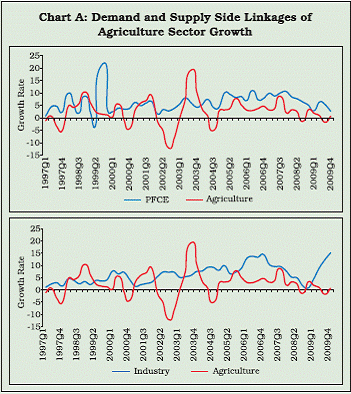 |
Table A: Inter-Sectoral Linkages |
|
Correlation Matrix |
Input- Output Table - Leontief Inverse** |
Inter-Sectoral Elasticities@ |
Agr |
Ind |
Serv |
Agr |
Ind |
Serv |
Agr |
Ind |
Serv |
|
Period I |
Agriculture |
- |
0.27 |
0.42 |
- |
0.20 |
0.06 |
- |
0.41 |
# |
Industry |
0.27 |
- |
0.54 |
0.13 |
- |
0.27 |
0.23 |
- |
0.80 |
Services |
0.42 |
0.54 |
- |
0.15 |
0.52 |
- |
0.25 |
0.88 |
- |
|
Period II |
Agriculture |
- |
0.07 |
0.05 |
- |
0.05 |
0.02 |
- |
0.29 |
# |
Industry |
0.07 |
- |
0.38 |
0.07 |
- |
0.15 |
0.23 |
- |
0.23^ |
Services |
0.05 |
0.38 |
- |
0.08 |
0.16 |
- |
0.21 |
0.56 |
- |
Agr: Agriculture, Ind: Industry, Serv: Services
Period I: correlation matrix (1966-90), I-O Table (1993-94) and elasticity (1951-
90); Period II: correlation matrix (1991-2008), I-O Table (2006-07) and elasticity
(1991-2008).
** : Coefficient represents requirement of row variable for producing one unit of
column variable.
@: Represents percentage change in column variable with one per cent change
in row variable.
# : Statistically insignificant; ^: Lagged impact. |
References
1. Rosenstein-Rodan (1943), “Problems of Industrialisation
of Eastern and South-Eastern Europe”, Economic
Journal, 53, 202–211.
2. Sastry D.V.S, Balwant Singh, Kaushik Bhattacharya
and N. K. Unnikrishnan (2003), “Sectoral Linkages
and Growth Prospects: Reflections on the Indian
Economy”, Economic and Political Weekly, 38,
2390–2397.
3. Subramaniam, Vijay and Michael Reed (2009),
“Agricultural Inter-Sectoral Linkages and Its
Contribution to Economic Growth in the Transition
Countries”, ageconsearch.umn.edu/bitstream.
Drought Mitigation
II.1.8 The performance of the South-West
monsoon in 2009, with a shortfall of 22 per cent in
precipitation, was the weakest since 1972. Of the
36 meteorological sub-divisions, the cumulative
rainfall was excess/normal in 14 sub-divisions and
deficient/scanty/no rain in 22 sub-divisions. Overall,
a drought situation was declared in 352 districts by
15 State Governments. Drought episodes in the
past have always adversely affected the agriculture
sector performance. The magnitude of decline in
production has varied depending upon the severity
of the drought. During 2009-10, foodgrains
production at 218.2 million tonnes declined only by
6.9 per cent as compared with a decline of around
18 per cent in 2002-03 - the previous drought year.
Moreover, GDP emanating from agriculture sector
increased by 0.2 per cent during 2009-10, despite
the decline in agricultural production (Chart II.2).
II.1.9 In order to mitigate the impact of drought
during 2009, several measures were initiated by
the Government. These include, (a) adoption of an
area-specific strategy to achieve higher production
through improved provision of inputs, viz.,
fertilisers, credit and pest control measures in areas
with higher rainfall, (b) advising the States to
prepare alternate plans for unsown/germinationfailed
areas with short duration/alternate crops,
(c) holding of zonal conferences and a Rabi
Campaign Programme with the State Governments
to enable formulation of an appropriate action plan
for the rabi season, (d) media telecasting/
broadcasting of agricultural advisories for appropriate crop programmes for the benefit of
farmers, (e) relaxing restrictions on seeds and
distribution of seed mini-kits under the National
Food Security Mission (NFSM) and Rashtriya Krishi
Vikas Yojana (RKVY), (f) making available funds
under Centrally sponsored programmes like the
NFSM, RKVY, Macro Management of Agriculture
Scheme (MMA) and Integrated Scheme of
Oilseeds, Pulses, Oil palm and Maize (ISOPOM)
to enable taking up of an agricultural reconstruction
programme, and (g) launching of Diesel Subsidy
Scheme to provide supplementary protective
irrigation to save the standing crops (50 per cent
of the cost of the subsidy with a cap of `7.50/litre
given by the States was borne by the Central
Government).
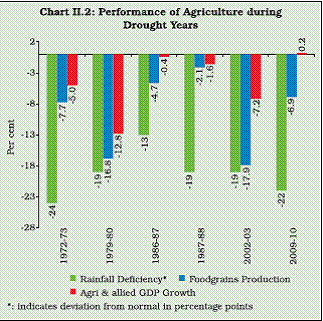 |
II.1.10 The positive contribution of the agriculture
sector to overall GDP during 2009-10 could partly
be ascribed to the structural changes, viz., declining
share of foodgrains and commercial crops in total
agricultural GDP, with a corresponding rise in the
share of horticulture, livestock, forestry and logging,
and fisheries. Moreover, rainfall in the month of July
2009, which is crucial for sowing of crops, was more
than normal. There was also an improvement in
soil moisture conditions, following satisfactory
performance of North-East monsoon season (8 per
cent above normal). Going forward, the long range
forecast for South-West monsoon season (June to
September 2010) released by the India
Meteorological Department indicates that the
rainfall for the country as a whole is likely to be
normal. Quantitatively, monsoon season rainfall is
likely to be 102 per cent of the long period average
(LPA) with a model error of ± 4 per cent. Although
cumulative rainfall during the season so far (up to
August 11, 2010) has been 4 per cent below the
LPA, the monsoon has been better than the last
year (-29 per cent). Area sown during kharif 2010
so far (as on August 13, 2010) has been higher
than in the corresponding period of previous year
for all crop categories. Thus, with higher kharif
output, the prospects for agricultural growth during
2010-11 would improve.
II.1.11 While the performance of agriculture sector
in 2009-10 in the face of a deficient monsoon has
been better than in previous drought episodes,
concerns still remain over the ability to withstand
successive years of drought. This underscores the
need to harness a second green revolution that is
also environmentally sustainable, with the focus
shifting from resource rich regions to those with
unfavourable agro-climatic conditions, so as to
bring about more inclusive growth. The Union
Budget for 2010-11, in this context, has announced
a strategy towards extending the green revolution
to the Eastern region.
II.1.12 Furthermore, heavy dependence on the
monsoon has resulted in a high degree of variability
in agriculture production leading to demand-supply mismatches that exert pressure on commodity
prices, particularly food prices. The year 2009-10
witnessed sharp increases in food prices,
particularly in pulses and sugar where demandsupply
imbalances at the margin led to a spurt in
prices. Farmers, however, often do not realise the
benefit of price hikes as there exist wide disparities
between farm gate and market prices. India, despite
being amongst the largest producers of several
agricultural commodities, lags in yields. Inter-State
and inter-crop yield differentials are also large
(Chart II.3). Consequently, demand-supply
imbalances have persisted, particularly in the case
of pulses and oilseeds. Although the shortfall in
domestic production has been met through imports
to an extent, this option at times is constrained by
the high international prices. As a result, whenever
there is a shortfall in domestic production, food
prices tend to come under pressure, leading
subsequently to a situation of generalised inflation.
Food Management
II.1.13 Reflecting the high levels of procurement
in 2008-09 and 2009-10, total food stocks increased
from 35.6 million tonnes at end-March 2009 to 43.4
million tonnes at end-March 2010 and further to
55.4 million tonnes as on August 1, 2010, i.e.,
significantly higher than the buffer stock norm of
31.9 million tonnes for the quarter beginning July 1
(inclusive of food security reserves of 5 million
tonnes). The rise in food stocks in the drought year
is in sharp contrast to what was observed in 2002-
03 - the previous drought year (Chart II.4). The high
level of food stocks and resilient production
conditions suggest that with better supply
management, the pressure on food inflation could
have been moderated. Moreover, maintaining high
food stocks involves significant carry costs.
II.1.14 The average growth rate of foodgrains
production at 1.6 per cent during 1990-2010 trailed
behind the average population growth of 1.9 per
cent. This has been reflected in the decline in the
per capita daily net availability of foodgrains from
472.6 grams per day in 1990 to 436.0 grams per day in 2008. There is clearly a need for a renewed
focus on improving agricultural productivity. Higher
investment backed by sustained research and extension activities could be critical for
augmenting yield. Greater focus needs to be
placed on agricultural research in the coming
years as the success so far has been restricted to
select crops. Moreover, the consumption basket
is getting diversified more in favour of milk,
vegetables, fruits, meat, poultry, fish and the like,
which are important from the nutritional angle.
Hence, it is also equally important to gradually
move away from the cereal-centric policy towards
these items, with supportive policy framework and
the required infrastructure. Market infrastructure
is important for the performance of various
marketing functions and for transmitting price
signals for efficient resource allocation. The policy
efforts need to be geared towards a reduction in
wastage of produce that occurs during storage and
management of supply chains. Public policies
have so far, focused more on price interventions
in the form of minimum support prices for the
producers and public distribution system for the consumers. There is need for reorientation of
public expenditure towards building capital
infrastructure for agriculture, which in turn, would
crowd-in private investment and help realise the
full potential of agriculture growth. The growth
strategy, to be effective and inclusive, has to
necessarily focus on stabilising the agricultural
production by achieving improved efficiency and
accelerated productivity levels in the farm sector.
 |
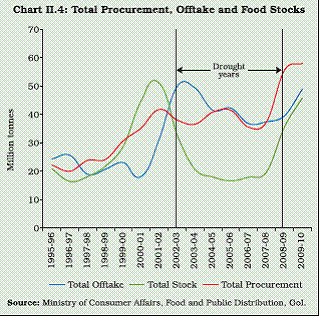 |
Industrial Performance
II.1.15 The Index of Industrial Production (IIP)
clocked a growth of 10.5 per cent during 2009-10
(2.8 per cent in 2008-09), bolstered by the double
digit growth since October 2009 (Chart II.5). The
recovery was broad-based with high growth in
manufacturing industries (10.9 per cent), followed
by mining (9.9 per cent) and electricity (6.0 per cent)
(Chart II.6). The manufacturing output growth rate
was supported by increases in consumer durables,
capital goods and intermediate goods production.
The strong performance of the manufacturing
sector during the second half of 2009-10 could
partly be attributed to the base effect. Despite the
large increase in the production of natural gas, iron
ore and other minerals, growth in the mining sector
remained at less than 10 per cent due to continued
slack in crude oil and coal output. The electricity
sector also lagged behind, owing to lower hydel
power generation in view of weak monsoon
conditions and the low level of reservoir capacity.
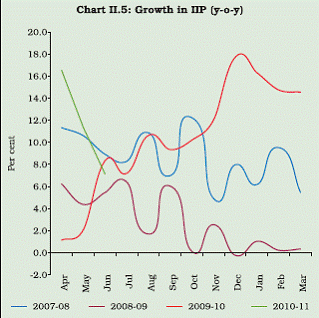 |
Similarly, inadequate coal production and delayed
imports adversely affected the coal availability,
leading to lower thermal generation.
II.1.16 The pace of recovery in industrial
production during 2009-10 is evident from the fact
that the IIP almost reached the level, which would
have been achieved had the high growth phase of
2005-07 not been interrupted in the subsequent two
years, on account of the global crisis (Chart II.7).
II.1.17 Besides the pace, the recovery was
relatively broad-based. The fastest growing five
industries with a combined weight of 24.6 per cent accounted for 63.5 per cent of overall
manufacturing growth in 2009-10 as compared with
134.6 per cent (weight 35.9 per cent) in 2008-09.
Similarly, the bottom 12 industries also contributed
to a substantially higher 36.5 per cent (weight 54.7
per cent) of the manufacturing growth in 2009-10
as compared with (-) 34.6 per cent (weight 43.4
per cent) in 2008-09.
 |
II.1.18 While the output of consumer durables
(26.2 per cent) and capital goods industries (19.2
per cent) gained strength during 2009-10, recovery
in the growth of non-durables (1.3 per cent) was
held back due to sluggishness in private
consumption demand (Chart II.8). The growth of
basic goods industries (7.2 per cent) supported the
recovery momentum, despite some concerns that
it may be difficult to sustain the growth in the wake
of capacity constraints in some industries. The
recovery in the intermediates goods segment (13.6
per cent) was initially driven by the turnaround in
inventory cycle, followed by a strong recovery in
investment demand.
II.1.19 During 2010-11 (up to June 2010),
consumer durables continued to record high growth
at 27.9 per cent. Basic goods (6.9 per cent), intermediate goods (9.8 per cent) and capital goods
industries (34.0 per cent) supported the buoyancy
in industrial growth. The growth in the capital
goods segment was aided by the rapid rise in
output of several industries like broad gauge
covered wagons, commercial vehicles, printing
machinery and air and gas compressors. This can
be attributed to the higher allocation for the
infrastructure sector by the Government, thereby
facilitating crowding-in of private investment in
machinery and construction sectors and
contributing to higher gross fixed capital formation
in the economy (Chart II.9).
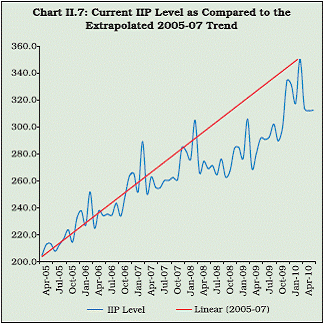 |
II.1.20 During the current financial year 2010-11
(up to June 2010), industrial sector maintained
double digit growth at 11.6 per cent. Though the
industrial output showed deceleration in the months
of May and June 2010, the pace of increase is still
robust. Notwithstanding some moderation in the
pace of industrial growth due to base effect and
possible subdued global demand, the industrial
activity is expected to remain buoyant.
II.1.21 The continuation of growth momentum
in the industrial sector in April-June 2010 suggests
stronger outlook for growth. However, concerns about the sustainability of high industrial growth at
the same pace during 2010-11 need to be
recognised. Weak external demand, notwithstanding
the pick-up in exports and moderation in
government expenditure on account of the fiscal
exit could moderate industrial growth. Revival in
private consumption demand, therefore, would be
critical for sustaining the recent performance of
the industrial sector. Improvement in the South-
West monsoon performance during June-July
2010, better agricultural production prospects,
change in income tax slabs in 2010-11 and the
permanent effect of the implementation of the
Sixth Pay Commission recommendations on
income should be supportive of consumption
demand.
Infrastructure
II.1.22 During 2009-10, the six core infrastructure
industries posted an improved performance over
the previous year. During 2010-11 (up to April-June
2010), the infrastructure industries recorded a
growth of 4.6 per cent, marginally higher than that
in the corresponding period last year (4.3 per cent)
(Chart II.10).
II.1.23 Infrastructure remains a key constraint to
growth in India. In several infrastructure projects,
significant time overruns and the resultant cost
overruns have delayed the actual realisation of
benefits of capacity addition. Capacity expansion
in critical sectors like crude oil and petroleum
refining remained weak and demand supply gap in
power sector also persisted. Both power
generation/transmission and distribution continue
to be the areas of concern. Power capacity addition
during 2009-10 was 9,585 MW as against the target
of 14,507 MW for the year. There are significant
capacity constraints in coal, ports and railways,
which may restrain high growth.
II.1.24 There are, however, fresh investments
taking place in power sector. The capacity
constraint in the crude oil sector is being addressed
through New Exploration Licensing Policy initiative
of the Government. Gas production from KG-basin
shows signs of optimism. Some external
acquisitions, particularly in steel, oil, gas and coal
too could support the domestic capacity gaps. The
public-private partnership mode is being given new
thrust with the help of multilateral institutions to
enhance availability of resources for infrastructure
investment. Recognising the challenge, the Union Budget for 2010-11 has allocated 46 per cent of
plan expenditure of the Central Government to
infrastructure. Overall, under the current
assessment, the Indian infrastructure industry is
expected to see significant increase in capacity
additions during 2010-11. This is also reflected in
the double-digit growth in capital goods production
during September 2009-June 2010.
Services Sector
II.1.25 The services sector had exhibited
significant resilience to the contagion from the
global crisis (Chart II.11). Services dependent on
external demand such as tourist arrivals, cargo
handled at major ports and passengers handled at
international terminals recovered during 2009-10,
although remained below the pre-crisis levels.
Domestic demand driven services such as
commercial vehicle sales, cell-phone connections,
railway traffic and construction activity showed high
growth, particularly during the second half of the
year. While production of commercial vehicles is
reflected under manufacturing activities, sales of
commercial vehicles provide lead information about
transportation services. Although the overall
services sector growth moderated in 2009-10, the services sector excluding “Community, Social and
Personal Services” showed a higher growth of
about 10 per cent in Q4:2009-10, which is higher
than average services sector growth rate recorded
during the high growth phase of 2003-08.
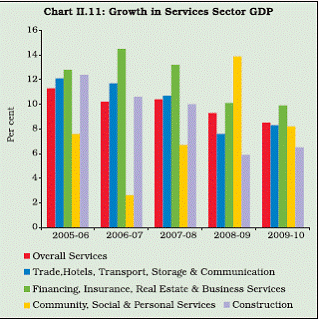 |
II.1.26 Total automobile production recovered in
2009-10, partly reflecting the lower production
base. Domestic sales rose substantially in 2009-10
(26.4 per cent) as compared to the preceding year
(0.7 per cent), while exports moderated (17.9 per
cent) from the level a year ago (23.6 per cent). In
the road sector, construction and widening of
national highways continued at a fast pace during
2009-10, while freight traffic carried by the railways
also increased. Cell-phone connections, both public
and private, continued to register a high growth (49.8
per cent), with the public sector connections growing
significantly (62.8 per cent). This segment was not
affected by the crisis induced slowdown in
2008-09. Aviation cargo movements, which had
declined since the onset of industrial slowdown
in 2008-09, recovered sharply during 2009-10
(Chart II.12). During April-July 2010, total automobile
production increased on the back of significant
increase in domestic sales (29.6 per cent) and
substantially high growth in exports (54.5 per cent).
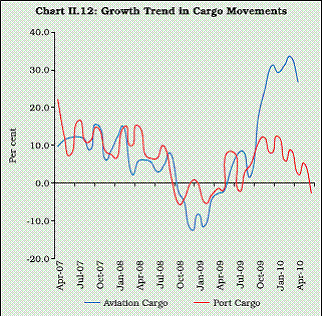 |
II.1.27 Going forward, the services sector is likely
to pick up further momentum from the growth in
the manufacturing sector. Retail trade and
construction are already showing signs of
buoyancy. The IT-BPO sector has also seen a
turnaround in terms of revenue and value creation
from the recessionary headwind of 2008-09. In
addition to the traditional business verticals, the
emerging verticals, viz., computing systems,
energy, infrastructure, industrial automation and
medical devices would assume significance. In the
domestic market, ICT enabled solutions will play a
greater role in healthcare, education, financial and
public services. In the case of a number of services
like hotels, communication, information and financial services, domestic demand continues to
be the major driver of growth.
II.1.28 With concerns about industrial recovery
receding by the end of the year, the issue of
productivity resurfaced in policy debates for
sustaining the high growth in the medium-term. In
this context, the Reserve Bank has taken a major
initiative to study industrial productivity at
disaggregated levels under India-KLEMS research
project. The project is a part of the larger Global
KLEMS initiative, which aims at an effective crosscountry
comparison of productivity at industry level
for understanding the competitiveness of
economies (Box II.3).
Box II.3
India KLEMS : An RBI Initiative to Measure Industrial Productivity in India
India KLEMS project is an extension of the existing
productivity research in India to identify growth drivers. The
project was commenced in September 2009, funded by the
Reserve Bank of India (RBI) as a research co-ordination
initiative between RBI and ICRIER.
The project is a part of the global initiative already
undertaken in many countries like Australia, Canada,
European Union (25 countries), USA, Latin America (4
countries), Russia, Japan, Korea, India and China to
estimate productivity in the Capital, Labour, Energy, Material
and Services (KLEMS) framework developed in the
European Union. The final objective of World KLEMS project
is to create an internationally comparable database for
estimating productivity at the sectoral levels to enable crosscountry
comparisons of productivity.
KLEMS framework of productivity estimates differs from
the traditional approach in a number of ways. First, it
intends to measure sector-wise productivity differential
explicitly. Second, it takes into account the heterogeneity
in inputs by creating explicit account for factor services.
To identify factor quality, it uses market price data,
assuming a competitive market. Third, in view of its
emphasis on disaggregated measurement, it attempts to
create KLEMS database meticulously without losing
comparability with the published and widely used National
Accounts data series. As the National Accounts data series
published by statistical agencies are hardly available at
such disaggregated details, generating KLEMS database
necessitates the use of extended sector-wise information
or related surveys. Fourth, comparisons of KLEMS data
over time and across countries could easily reveal structural
change and evolving input-output relations between industries, input usage intensity (such as investment in
human and physical capital) and productivity growth
(technological change, terms of trade, etc.). Finally, it can
link the proximate sources of growth to policy initiatives
like market reforms, sector specific regulations, trade/
external policies and regional policies.
India-KLEMS is a three year project. In the first phase,
preliminary estimates of productivity of 31 sectors covering
the entire economy using value added growth accounting
model with labour hours and capital stock as factor inputs
have been worked out (Table A). This exercise would be
extended to compute productivity estimates in gross output
based accounting framework by developing material,
energy and services (MES) data series in the next two years
of the project.
The overall GDP growth during 1992-97 at 6.2 per cent was
accompanied by a sizeable TFP growth across sectors.
Deceleration in overall growth during 1997-2005 is partly
attributable to the deceleration in productivity growth to 1.7
per cent from 2.6 per cent during 1992-97, notwithstanding
a rise in TFP growth in services sector.
For the entire period (1980-2005), the TFP growth in services
sector (2.1 per cent) is higher than both in agriculture (1.6
per cent) as well as in industries (1.4 per cent). Productivity
growth in industry improved considerably after 1986
compensating for the slowdown in the contribution of inputs
to the overall growth. The higher TFP growth in agriculture
during 1980-97 offsets a somewhat lower contribution of
inputs during this period. While the productivity in agriculture
fell during 1997-2005, its impact on growth was muted due
to enhanced contribution of inputs.
Table A : Total Factor Productivity (TFP) and GDP Growth |
(Per cent) |
Sectors |
1980-1986 |
1986-1991 |
1992-1997 |
1997-2005 |
1980-2005 |
|
TFP |
GDP |
TFP |
GDP |
TFP |
GDP |
TFP |
GDP |
TFP |
GDP |
Total Economy |
2.2 |
5.3 |
1.6 |
5.9 |
2.6 |
6.5 |
1.7 |
5.7 |
1.9 |
5.7 |
|
|
(3.1) |
|
(4.3) |
|
(3.9) |
|
(4.0) |
|
(3.8) |
Agriculture |
2.5 |
3.7 |
2.4 |
3.8 |
3.0 |
4.8 |
-0.2 |
2.2 |
1.6 |
3.4 |
|
|
(1.2) |
|
(1.4) |
|
(1.8) |
|
(2.4) |
|
(1.8) |
Industry |
-0.3 |
6.2 |
1.6 |
7.2 |
3.1 |
7.3 |
1.4 |
5.1 |
1.4 |
6.0 |
|
|
(6.5) |
|
(5.6) |
|
(4.2) |
|
(3.7) |
|
(4.6) |
Services |
3.4 |
5.8 |
1.0 |
6.9 |
2.0 |
7.3 |
2.2 |
7.9 |
2.1 |
7.0 |
|
|
(2.4) |
|
(5.9) |
|
(5.3) |
|
(5.7) |
|
(4.9) |
Note: Figures in parentheses represent overall growth explained by inputs alone.
Source: CSO (NAS) and India KLEMS estimation of sectoral TFPs. Construction is considered as part of services as per NAS. Weights are given as
share of value added of 31 sectors. |
References:
1. Schreyer, Paul Spring (2001), “The OECD Productivity
Manual: A Guide to the Measurement of Industry-level
and Aggregate Productivity”, International Productivity
Monitor, volume 2, pages: 37-51.
2. Jorgenson W. Dale (2009), “The Economics of
Productivity”, The International Library of Critical Writings
in Economics.
3. University of Groningen (2010), “India KLEMS
Workshop”, April 15-16, Groningen, the Netherlands.
AGGREGATE DEMAND
II.1.29 The drivers of aggregate demand changed
significantly during 2008-09 and 2009-10
(Chart II.13 and II.14). The growth in private final
consumption expenditure moderated from 8.0 per
cent in the first half of 2008-09 to 5.8 per cent in
the second half and further to 4.6 per cent in the
first half of 2009-10, reflecting economic slowdown, poor agriculture production and high food prices.
Fiscal measures were initiated (for details see
Section II.5) to offset the slack in private demand.
Consequently, the growth in government final
consumption expenditure increased significantly
from 5.5 per cent in the first half of 2008-09 to 25.7
per cent in the second half of 2008-09 and 22.5
per cent in first half of 2009-10, reflecting the
expansionary fiscal response to the crisis. The rate of increase in gross fixed capital formation (GFCF)
fell from 6.9 per cent in the first half of 2008-09 to
1.3 per cent in second half and further to 0.5 per
cent in the first half of 2009-10.
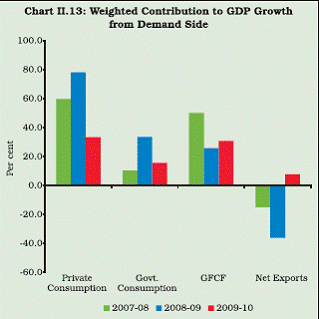 |
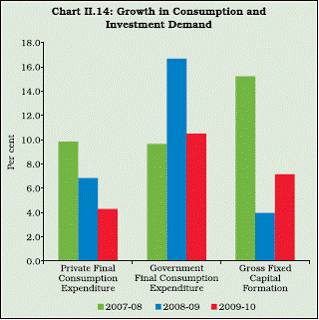 |
II.1.30 In the second half of 2009-10, private
consumption demand continued to remain sluggish,
while the government consumption expenditure
moderated substantially due to the base effect. The
gross fixed capital formation emerged as the major
driver of growth during the second half of 2009-10,
exhibiting a growth of 13.4 per cent and contributing
around 46.3 per cent to the overall GDP growth.
Another notable shift in contribution to growth
emerged from net exports, as exports recovered
in the second half, ahead of imports. This was more
due to declining imports than growing exports. As
a result, the contribution of net exports to GDP
growth improved from a negative 17.9 per cent in
the first half to a positive 22.2 per cent in the second
half of 2009-10.
II.1.31 The assessment of drivers of growth from
the supply side and demand side suggests that due
to lower contribution of agriculture to the strong
recovery and subdued consumption demand, in
which rural demand has a large share, the
distribution of benefits of growth would have
possibly changed. The expansionary fiscal stance
that was adopted to stimulate the recovery,
however, had a major component in the form of
higher expenditure under NREGA. Thus, the policy
stimulus contributed to a faster recovery, while also aiming at improving the distribution of the benefits
of growth.
II.1.32 Going forward in 2010-11, with fiscal
consolidation plans already outlined in the Budget
and contribution of net exports to overall growth
expected to reverse, the key drivers of growth
would be private consumption and investment
demand. The revival in private investment demand
has been strong in recent quarters. Production
trends in capital goods suggest that this pattern
may continue. Industrial recovery, significant
increase in government spending on infrastructure
projects, improved business sentiments and
capacity expansion plans in the pipeline for many
industries suggest that the investment demand
would provide momentum to growth in 2010-11.
Saving and Capital Formation
II.1.33 The aggregate savings rate moderated
from 36.4 per cent in 2007-08 to 32.5 per cent of
GDP in 2008-09, reflecting a sharp fall in public
sector savings on account of the impact of the fiscal
stimulus measures. The investment rate moderated
from 37.7 per cent in 2007-08 to 34.9 per cent in
2008-09, mainly on account of a decline in the
investment of private corporate sector (Chart II.15).
II.1.34 During 2009-10, the public sector savings
are likely to remain subdued on account of higher
revenue deficit of the Government. The private
corporate savings are expected to increase due to
improved profitability.
II.1.35 Preliminary estimates, based on the latest
available information, place financial savings (net)
of the household sector in 2009-10 at 11.9 per cent
of GDP at current market prices, which is higher
than the estimates for 2008-09 at 10.2 per cent
(Chart II.16). Despite a slower growth in bank
deposits partly due to lower deposit interest rates,
a turnaround in the household financial savings in
2009-10 was made possible by a revival in almost
all other components. Sharp recovery was noted
in the household savings in life insurance, public
provident funds, small savings, senior citizen
deposit schemes and mutual funds. Moreover,
recovery in economic growth contributed to a pickup
in household financial savings.
II. PRICE SITUATION
II.2.1 The inflation path changed course
significantly over two distinct phases during 2009-
10. The subdued headline inflation in the first half
provided the necessary preconditions for sustaining
the recovery supporting monetary policy stance. In
the second half, increasing generalisation of the
inflation process necessitated a gradual shift in the
balance of policy focus to containment of inflation
expectations while still remaining supportive of recovery. A stronger and broad-based recovery
also facilitated gradual unwinding of the
accommodative monetary policy stance. On
account of the persisting uncertainties about the
nature of the global recovery and strength of
domestic private demand, the overall policy stance
had to remain sensitive to the growth objective while
increasing the weight of policy focus on
management of inflation.
II.2.2 Year-on-year wholesale price index (WPI)
inflation remained low during the first half of the
year (negative during June-August 2009) and
increased faster in the second half to reach 11.0
per cent by March 2010. The base effect of high
prices in the first half of 2008-09 contributed to the
low inflation during the first half of 2009-10. The
waning of base effect along with sharp increase in
food and oil prices on account of lower agricultural
production and increase in international
commodity prices, especially oil, contributed to the
faster increase in inflation during the second half
(Chart II.17). The build-up of inflationary pressures,
however, was visible throughout the year as WPI
exhibited strong uptrend over successive months
during the year. Inflationary pressures, which
remained concentrated on a few commodities
during the major part of the year, became
increasingly generalised during the last quarter of
2009-10, as more number of commodities exhibited
increase in prices.
II.2.3 The contribution of different items/groups
in the WPI basket to overall headline inflation
during 2009-10 changed significantly (Chart II.18a).
Food inflation remained high throughout 2009-10,
showing some moderation since December 2009,
particularly in manufactured food products
(Chart II.18b). The decline in manufactured food
price inflation was led by sugar prices, which fell
by 16.0 per cent during January-July 2010 after
increasing by 53.6 per cent during March 2009-
January 2010. Reflecting this decline as also the
increase in non-food inflation, the contribution of
food items to overall inflation declined from over to
100 per cent in November 2009 to about 23 per
cent by July 2010.
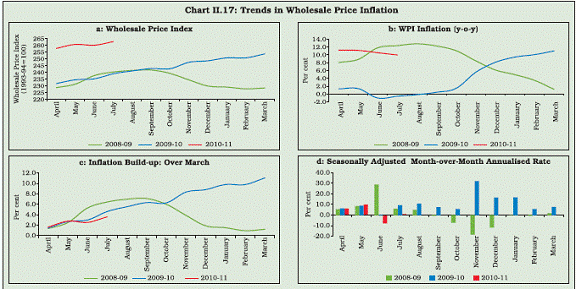 |
II.2.4 Fuel group which contributed negatively to
overall inflation since January 2009 showed a
reversal of trend in the last four months of the year.
The contribution of the non-food manufactured
products group, which remained negative during
April-November 2009, turned around and increased
significantly thereafter, indicating generalisation of
inflationary pressures. The year-on-year increase
in WPI, however, was dominated by increase in
prices of food and oil, with a combined weighted
contribution of 59.4 per cent (Chart II.19). The
weighted contribution of these two groups to the
WPI inflation has generally been higher than their combined weight in the WPI (Chart II.20). This
reflects persistent supply side pressures on the
inflation path.
II.2.5 Significant increases in international
commodity prices, particularly oil, during 2009-
10 added further pressures on domestic prices
(Chart II.21a). The increase in key international
commodity prices during 2009-10 was significantly
higher than the domestic inflation, thereby limiting
import as an option for price control (Chart II.21b).
Since April 2010, however, some decline in
commodity prices has been observed, as greater uncertainty relating to recovery in advanced
economies following the developments in Euro
zone spilled over to commodity markets.
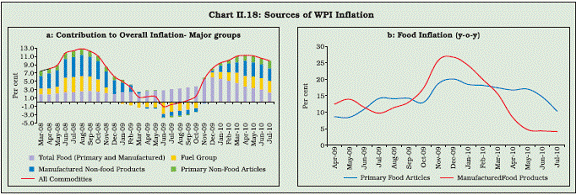 |
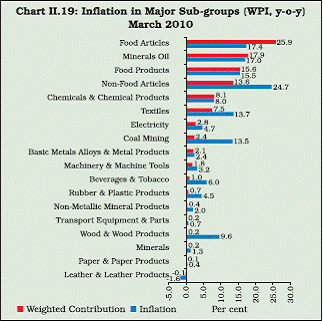 |
II.2.6 Speculation in commodity futures was seen
in some quarters as a factor behind the high food
inflation during 2009-10. Whether activities in
commodity futures market reflect genuine needs
of hedging or speculation, and whether such
activities systematically influence the commodity
prices and lead to increased price volatility, are
questions that largely remain unsettled in academic
and policy discussions (Box II.4). In India, several
commodities which are not traded in the commodities exchange, such as fruits and milk,
exhibited price increases during the year.
Moreover, certain commodities that were banned
for trading in 2007, such as rice, wheat, tur and
urad, also exhibited price increases subsequently.
Even after the ban imposed on trading of sugar in
2009, sugar prices continued to increase. On the
other hand, prices of certain essential commodities
that are being traded in the futures market, such
as gram, chillies, rapeseed oil and coconut oil,
either remained moderate or declined during
2009-10. Despite the persisting ambiguity about the
relationship between futures market activities and
spot prices of commodities, activities in the futures market need to be better monitored, given the
possible role this market may have for the overall
inflation conditions.
 |
 |
Box II.4
Impact of Trading in the Commodity Futures Market on Inflation
With growing financialisation of commodities, the role of
speculative activities in commodity exchanges as a
determinant of inflation has often been highlighted as an
issue of policy relevance, particularly during episodes of high
inflation driven by supply shocks involving commodities such
as oil and metals as well as agricultural output. The
financialisation channel is often perceived to have magnified
the impact of disequilibrium between demand and supply in
specific commodities on prices, weakening thereby the role
of fundamentals in the price formation process. More
importantly, speculation that affects futures prices has been
argued to affect spot prices through the channel of arbitrage.
The sharp volatility in international commodity prices since
2008 has increased the analytical focus on studying the
interactions between prices in spot and futures markets for
commodities. According to the UNCTAD (2010)
“…extraordinary increases in the volume of commodity
derivatives as asset classes attracted swings of short-term
portfolio investments, causing prices to deviate further from
their trend levels. This increasing interest in commodities
as an asset class has been termed the financialisation of
commodity markets, which is a relatively new factor in price
formation in commodity futures markets…”. According to
the IMF (2006), perceptions are often driven by observation
of correlation rather than assessment of causality. The IMF’s
assessment based on causality suggested “…little support
for the hypothesis that speculative activity (as measured by
net long non-commercial positions) affects either price levels
over the long run or price swings in the short run. In contrast,
there is evidence (both across commodities and over time)
that speculative positions follow price movements.”
Increases in food and essential commodity prices in India
in 2009-10 brought to the fore the debate on the role of
commodity futures market in influencing price trends. The
share of agricultural commodities in overall futures trading
has declined in recent years reflecting imposition of bans on
trading of several commodities (Chart A). Against the
backdrop of growing perception that manipulative activity
was causing distortions in the futures market and stoking
inflation, the Government of India had constituted an Expert
Committee on Futures Trading (ECFT) in 2007 with Prof.
Abhijit Sen as the Chairman to study the effects of futures
trading on prices of agricultural commodities in the country.
The Committee viewed that no strong conclusion can be
drawn on whether introduction of futures trade is associated
with decrease or increase in spot price volatility. While many
other studies have examined the relationship between spot
and futures prices, empirical evidence remains mixed.
The standard approach to study the impact of futures trading
in commodities on their spot prices is through Granger causality
tests. The empirical analysis for India is often constrained by
the breaks in data on account of imposition of frequent bans
and subsequent permission for relisting of certain essential
commodities in the commodities exchange. Causality test
results relating to the sample period for which data are available
indicate that futures prices have causal impact on spot prices
in the case of sugar and urad (Table A). It is also observed
that spot prices Granger cause futures prices in case of urad,
chana, wheat and sugar. Sugar and urad seem to exhibit twoway
causality between the spot and futures prices.
Table A: Granger Causality Tests of the Relationship
Between Spot and Futures Prices of
Agricultural Commodities |
Commodity |
Hypothesis on the Direction of Causality |
Futures Prices do not
cause Spot Prices |
Spot Prices do not
cause Futures Prices |
Significant* |
P Value |
Significant* |
P Value |
1 |
2 |
3 |
4 |
5 |
Sugar |
Yes |
0.00 |
Yes |
0.00 |
Urad |
Yes |
0.00 |
Yes |
0.00 |
Tur |
No |
0.21 |
No |
0.42 |
Wheat |
No |
0.42 |
Yes |
0.04 |
Chana |
No |
0.74 |
Yes |
0.07 |
Potatoes |
No |
0.14 |
No |
0.81 |
* If significant, the null hypothesis is rejected.
Note: The tests relate to monthly data for the period 2004 to 2009.
For commodities on which ban was imposed, data for the
period 2004-2007 were used. |
The empirical analysis, thus, does not provide any conclusive
evidence in support of the relationship between spot and
future prices. Commodity prices in India seem to be influenced
more by other drivers of price changes, particularly demandsupply
gap in specific commodities, the degree of dependence
on imports and international price movements in these
commodities.
References
1. Government of India (2008), Report of the Expert
Committee to Study the Impact of Futures Trading on
Agricultural Commodity Prices, Ministry of Consumer
Affairs, Food & Public Distribution.
2. IMF (2006), “The Boom in Non-Fuel Commodity Prices:
Can it Last?”, World Economic Outlook, October,
Chapter-5.
3. UNCTAD (2010), Recent Developments in Key
Commodity Markets: Trends and Challenges, United
Nations Conference on Trade and Development, Geneva.
II.2.7 Demand-supply imbalances in certain
commodities seem to be widening in recent
years, causing significant swings in their prices.
Barring a few edible oils and pulses, India has
so far met the bulk of its food demand through
domestic production. For wheat and sugar, India
has occasionally resorted to imports, though
generally it is an exporter of these commodities.
In the case of edible oils, the demand has far
outstripped the domestic supply and the deficit
is met through imports, the share of imports being
around 35 per cent of the total consumption.
Pulses production has also lagged behind the
demand resulting in dependence on imports to the
extent of 14-15 per cent. There is a risk of Indian
imports inflating international prices, and in that
process, at times, the import option to contain
inflationary pressures at home may not be there.
In the case of commodities like crude oil, where
the import dependence is more than 80 per cent,
while full pass through of international prices to
domestic prices has implications for inflation in the
short-run, it will contribute to price stability by
alleviating the pressure on the fiscal situation. The
deregulation, besides contributing to improve the
fiscal situation, could also promote energy
efficiency and conservation.
II.2.8 The increase in inflation in certain
commodities could also be on account of structural
factors, which could create long-term supply
bottlenecks. As the growth in food production has
been lower than the overall growth in population,
the net availability of food has come down, which
gets partly reflected in sustained increase in prices.
Moreover, as the economy exhibits stronger
inclusive growth, the resultant increase in income
of the population at large would lead to shift in the
pattern of demand, and consumption of food items
like pulses, milk and sugar could increase, which
would exert pressure on prices of those products
for which supply response may lag behind the
growing demand.
II.2.9 In recent months, much of the pressure on
the headline inflation has emanated from either
upward revisions in administered prices (such as
coal, fertiliser, electricity and petroleum products)
or lagged reporting of inflation that gets reflected
in the revised WPI data. Lower administered prices
represent suppressed inflation and when their
prices are revised upwards, the actual inflation path
moves up. The increase in prices of petroleum
products in June 2010 alone entailed an immediate
increase in headline inflation by about one
percentage points and the expected overall impact
(including full pass-through across sectors in the
second round, through higher input costs) could
be about 2.9 percentage points.
II.2.10 The identification of sources of inflation is
important for the conduct of monetary policy.
Tightening of monetary policy in the face of demand
pressures could yield desirable results by
containing monetary policy sensitive part of the
demand. However, when the inflationary pressures
are dominated by adverse supply shocks, monetary
policy could be less effective in containing price
pressures. Supply shocks, however, generally tend
to alter relative prices, and in certain conditions,
relative price trends could necessitate monetary
policy actions, as has been the case for India in
the last quarter of 2009-10 (Box II.5).
II.2.11 Since the inflationary situation during
2009-10 largely emerged from the supply side
constraints, the government took a number of short
and medium-term fiscal and administrative measures
to improve domestic availability of essential
commodities and thereby moderate the pressure on
inflation. These included, reduction of import duty to
zero for select food items like rice, wheat, pulses,
edible oils (crude), sugar and maize; additional
allocation of foodgrains for sale through public
distribution system (PDS) and allocation of wheat
for release by the Food Corporation of India (FCI) in
the open market; ban on export of non-basmati rice,
edible oils and pulses; distribution of imported pulses
and edible oils thorough PDS at subsidised rates
and increase in Minimum Support Price of key
agricultural commodities to augment production.
Box II.5
Supply Shocks, Relative Price Changes and the Role of Monetary Policy
Inflation refers to general increase in the price level, which
is conventionally measured as the growth rate of a price
index. Such a measure of inflation could be seen as a
proper representative of the underlying inflationary
pressures only when relative prices of commodities within
the basket of the selected overall index remain constant.
A measure of headline inflation rarely reflects the
movements in prices of all the commodities in the basket in
the same direction and by the same magnitude. Divergent
trends in movements of prices across commodities within
the basket and the resultant changes in relative prices could
make the average inflation less representative, particularly
for the purpose of conduct of monetary policy.
Changes in relative prices have been significant for India
in recent years, particularly because of the dominance of
supply shocks in conditioning the overall inflation path. In
this context, four specific issues are important for the
conduct of monetary policy: (a) possible misleading
information from the headline inflation in the presence of
divergent trends in inflation across commodities, (b) the
risk of higher relative price variability in itself causing higher
headline inflation, (c) the challenge of segregating supply
side triggers for relative price changes from demand side
factors, and most importantly (d) what monetary policy
could do to contain inflationary pressures emanating from
shifts in relative prices.
In India, the dominance of supply shocks in affecting the
underlying trend inflation is borne out by the Granger
causality tests (Table A). The test results suggest the
presence of unidirectional causality with ‘food and fuel
inflation’, reflecting the supply shocks, Granger causing
the changes in core inflation. The “non-oil non-food
component” is used as a measure of core inflation for this
test. Although the results are significant only at 10 per
cent level, the results indicate supply shocks contributing
to possible second round effects.
Table A: Causal Relationship between Supply
Shocks and Underlying Inflation |
(Sample April 1994 to March 2010) |
Null Hypothesis: |
F-Statistic |
Prob. |
Core Inflation does not Granger cause food and fuel inflation |
1.09 |
0.34 |
Food and fuel inflation does not Granger cause core Inflation |
2.73 |
0.07 |
The second round effects represent the risks to overall
inflation from shifts in relative prices that originate through
supply shocks. The second round impact often materialises
with a lag and operates through inflation expectations,
wage settlements and price setting behaviour of firms. In practice, however, it is hard to distinguish first and second
round impact. It may also be not correct to ascribe any
change in relative prices to supply shocks. The variance
decomposition analysis based on a structural VAR
framework sheds light on the impact of supply shocks on
India’s headline inflation. About one-third of the variation
in the headline inflation over the horizon of two years seems
to have been explained by the supply shocks (food and
oil). It is also to be noted that the impact of oil shocks has
a relatively greater impact (about 20 per cent) on variation
in headline inflation as compared to food shocks (about
14 per cent). The empirical results also indicate that about
54 per cent of the variation in the headline inflation is
caused by the residual shocks to the headline inflation itself,
which is suggestive of the role of inflation persistence and
inflation expectations in explaining the inflation process.
As regards monetary policy response to relative price
developments, it has been generally argued that monetary
policy actions may not be effective in controlling relative
price movements resulting from supply shocks. For
temporary increases in prices of certain items, on account
of supply shocks, monetary policy need not respond. In
turn, if the changes in relative prices are permanent (i.e.,
the changes in relative price persists), and lead to higher
general inflation, through second round impact and
adverse inflation expectations, monetary policy will have
a role for anchoring inflationary expectations. As
emphasised by Mishkin (2007), higher inflation resulting
from adverse supply shocks may not merit monetary
tightening “... as long as the permanent changes in relative
energy price do not lead to a change in the underlying
trend rate in inflation”. Given the possibility of the shortterm
trade-off between inflation and growth, however,
monetary policy actions aimed at containing inflation may
induce some sacrifice of growth. In this context, Feldstein
(2009) noted that an appropriate strategy for a central bank
could be to recognise “...that a tight monetary policy will
slow growth in the short-term... (but) produce stronger
growth and lower risks for the longer term”.
Relative price changes can be identified by looking at the
variability in inflation across commodities within the general
price index. The index of relative price variability (RPV) is
measured as the weighted sum of deviations in
commodities inflation from overall inflation :
In India, during the first half of 2009-10, despite inflation
remaining low, relative price variability increased
substantially indicating the presence of supply shocks
(Chart A). Since November 2009, the relative price
variability has declined, despite inflation remaining high,
indicating that the inflation has become increasingly
generalised, and hence, requiring appropriate monetary
policy actions to anchor inflation expectations.
References
1. Feldstein, Martin (2009), “Beyond Price Stability: the
Challenges Ahead”, BIS Papers No.45, Bank for
International Settlement.
2. Mishkin, Frederic S (2007), “Headline versus Core
Inflation in the Conduct of Monetary Policy” , Speech
at the Business Cycles, International Transmission
and Macroeconomic Policies Conference, HEC
Montreal, October 20.
II.2.12 The emergence of demand pressure on
prices in India during the last quarter of 2009-10
was visible from a number of indicators, such as
strong revival in import growth, major turnaround
in corporate sales, increases in capacity utilisation
and revival in credit demand from the private sector.
Apart from this, the pricing power of corporates also
seemed to improve with recovering private demand,
which is evident from the trends in net response
reported in the Reserve Bank’s Industrial Outlook
Survey (Chart II.22). While the corporates expected
in larger numbers to be able to raise output prices,
they also expected input costs to increase,
indicating the cost-push effects of supply shocks
on general inflation.
II.2.13 Persisting divergence between inflation as
measured by wholesale and consumer price indices
was another major feature of inflation trends in India
during 2009-10 (Chart II.23). The divergence was
partly the result of high inflation in food, which has
relatively higher weight in CPIs as compared to WPI. During the second half of 2009-10, some
decline in the degree of divergence was witnessed
as a result of increase in WPI inflation and
moderation in CPI inflation.
II.2.14 Besides divergence in inflation across
commodities and price indices, the differences in
inflation across states has also been significant
(Chart II.24).
II.2.15 High inflation, when persists, could not only
dampen overall growth prospects of the economy
but also hamper the progress on inclusive growth.
The adverse impact on growth could potentially
result from inflation induced distortion in resource
allocation and possible decline in domestic
savings. Uncertainty associated with inflation could
complicate investment and consumption planning,
affecting capital accumulation and savings.
Inflation at times, could also shift the focus from
production activities and productivity enhancing
investment to speculation and hoarding.
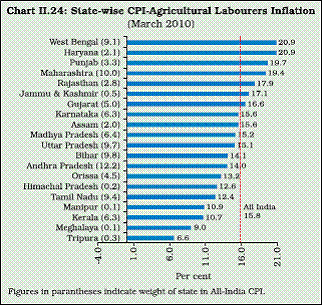 |
II.2.16 The risk to inclusive growth may result from
the asymmetric impact of inflation on different
sections of the population. A large section of the
population may not be able to increase their
nominal income matching inflation and in that
process may suffer a decline in real income. The
impact of high food inflation could be even more
asymmetric, because of the large proportion of
income of the poor that is allocated to consumption
of food items. In view of the possibility that those
who experience maximum loss of real income
because of high inflation also do not benefit much
from high growth, containment of inflation becomes
the overriding objective for monetary policy in the
eventuality of inflation persistence (Box II.6). The
evidence of inflation persistence in India in the recent period suggests that despite the risk of
possible trade off between growth and inflation in
the short-run, inflation containment may have to
receive precedence over other policy objectives in
India for the Reserve Bank.
Box II.6
Inflation Persistence in India
Inflation is said to be persistent if, in the absence of any
disturbance, it shows a tendency to stay closer to its past
levels. Inflation persistence implies the time taken by
inflation to return to the underlying trend after a shock. If
inflation exhibits a sudden spike on account of supply
shocks and does not moderate thereafter, the resultant
inflation persistence could raise its long-run average
value. Hence, higher the persistence of inflation, stronger
monetary policy actions may be required to bring inflation
down to the long-term trend, following a supply shock.
Though inflation persistence is often viewed as an
important information, which should feed into the
monetary policy making process, there is little agreement
in the literature on how best to measure inflation
persistence. The nature of inflation persistence could vary
both across time and across different supply shocks. Two
distinct approaches are seen in the literature to measure
inflation persistence: one defines and evaluates inflation persistence in the context of a simple univariate timeseries
representation of inflation, while the other uses a
structural econometric model that aims at explaining the
inflation behaviour. Under the univariate approach (also
called reduced-form approach), a simple autoregressive
model for inflation is used and the shocks are measured
in the white noise component of the autoregressive
process. The multivariate approach implicitly or explicitly
assumes a causal economic relationship between
inflation and its determinants (usually through a structural
VAR model) and sees inflation persistence as referring
to the duration of the effects of various shocks on inflation.
While in the univariate approach shocks to inflation are
not identified, under the multivariate approach attempts
are made to identify different shocks to facilitate shockspecific
persistence analysis.
Empirical studies on inflation persistence in India give
contrasting results. Khundrakpam (2009) found that
irrespective of the alternative inflation measures, the level
of inflation persistence in India is relatively on the lower
side, although among the components of WPI,
‘manufacturing’ inflation is the most persistent.
Different approaches used to understand the nature of
inflation persistence in India indicate almost similar results.
These include: (a) conventional unit root tests: a series
with a unit root has infinite memory in the sense that a
shock in period t has influence on all periods t + k; k > 0.
Thus, any shock to a series with a unit root persists forever;
(b) the first order autocorrelation of the inflation series;
(c) the autocorrelation function of the inflation series and
(d) the sum of the autoregressive coefficients for inflation.
Empirically, these measures are examined using WPI
(base: 1993-94=100) data from April 1995 to April 2010.
Since 2000, monetary policy operates under the LAF
framework. Thus, in order to assess this shift on inflation
persistence, the sample period is split into two sub-periods:
April 1995 to March 2000 and April 2000 to April 2010.
The conventional unit root tests suggests that for splitsample
and the whole sample, WPI-based inflation does
not contain a unit root, more so in the later half of the
sample (Table A). That means inflation process has been
less persistent during post-2000 period.
Table A : Unit Root Tests for Inflation |
|
P-Value (Null hypothesis : Series has unit root) |
Apr-95 to
Apr-10 |
Apr-95 to
Mar-00 |
Apr-00
to Apr-10 |
ADF test |
0.0154 |
0.0437 |
0.0000 |
Phillips-Perron |
0.0019 |
0.0453 |
0.0332 |
Secondly, the first order autocorrelation coefficient, a
simple measure of persistence, showed the time varying
nature of persistence (Chart A). Inflation persistence seems more pronounced in the recent period. The
autocorrelation structure does not rule out persistence,
but only suggests low persistence (Chart B). Finally, a
persistence test based on AR model suggests that WPI
inflation exhibits persistence (Table B).
Table B: Persistence Test Based on AR(k) Process |
|
Apr-95 to
Apr-10 |
Apr-95 to
Mar-00 |
Apr-00 to
Apr-10 |
Sum of the AR coefficients |
0.8431(AR(3)) |
0.8416(AR(1)) |
0.8380(AR(3)) |
P-value |
<.0001 |
<.0001 |
<.0001 |
Different estimates, thus, suggest that inflation persistence
has been a reality. Highlighting empirical evidence on the
high degree of inflation persistence in India in the recent
period, especially in the case of food and edible oil
groups, Mohanty (2010) emphasised that “… extent of
inflation persistence is important in the determination of
the pace of monetary policy adjustment to achieve the
desired target”.
References
1. Khundrakpam K. Jeevan (2008), “How Persistent is
Inflationary Process, Has it Changed?”, Reserve Bank of
India Occasional Papers, Vol.29, No.2.
2. Mohanty, Deepak (2010), “Inflation Dynamics in India:
Issues and Concerns” Speech delivered at the Bombay
Chamber of Commerce and Industry, March 4, 2010.
Developments in 2010-11 so far :
II.2.17 In the first quarter of 2010-11, the headline
inflation remained close to double digits (9.97 per
cent, y-o-y, provisional in July 2010), despite some
moderation in prices of food products. WPI inflation
based on revised data for first three months of
2010-11 was higher by over one percentage point
in each month as compared with the provisional
figures. Manufactured non-food products inflation
further accelerated, and remains elevated
indicating the strengthening of demand side
pressures on inflation. Changes in administered
prices as well as upward revisions in price indices
that reflected lagged reporting of past price
increases, contributed significantly to the increase
in WPI in recent months. Notwithstanding some
moderation, consumer price inflation, measured by
various indices, remains high in the range of 13.0-
14.1 per cent during May/June 2010.
II.2.18 High and persistent inflation at the current
juncture poses a number of challenges. The
increasing generalisation of inflation indicates
emergence of inflationary pressures from the
demand side, which will require active demand
management policies in the near-term. The focus
of medium-term inflation management, however,
must be to ease supply constraints in key sectors
where demand will continue to grow. This is
particularly important for agricultural products. It
also needs to be recognised that high and
generalised inflation, if persists, in itself is a risk to
growth through its unfavourable effects on resource
allocation as well as unfavourable redistributive
effects on the poor. Large dispersion in inflation,
across commodities, across regions and across
different indices also necessitate the use of multiple
indicators of inflation for the assessment of overall
inflationary conditions.
III. MONEY AND CREDIT
II.3.1 Monetary and credit conditions remained
supportive of recovery during 2009-10, largely
reflecting the accommodative monetary policy
stance of the Reserve Bank. Easy access to
liquidity at low cost was a critical component of the
overall policy response in the management of
recovery. The Reserve Bank, like most other central
banks, adopted a number of conventional and
unconventional measures in the second half of
2008-09 to augment domestic and foreign
exchange liquidity. In a span of seven months
between October 2008 and April 2009, there was
unprecedented policy activism, as the repo rate was
reduced by 425 basis points to 4.75 per cent, the
reverse repo rate was reduced by 275 basis points
to 3.25 per cent and the CRR was reduced by 400
basis points to 5.0 per cent. The actual/potential
provision of primary liquidity was of the order of
`5,60,000 crore (9.0 per cent of GDP).
II.3.2 Accommodative monetary policy stance
continued through the first half of 2009-10. As the
recovery process gained momentum and in
response to the emerging inflationary pressures,
calibrated monetary unwinding started in the
second half of the year. Notwithstanding the easy
monetary policy, on account of the significant
deceleration in private consumption and investment
demand, particularly in the first half of the year,
growth in monetary and credit aggregates
decelerated. In the second half of the year, pick-up
in the momentum of recovery led by industrial
growth was not reflected as much in the trends for
money growth, though credit growth recovered from
November 2009. In 2010-11 so far, credit growth
continued to accelerate during the first quarter and
showed some moderation in July 2010, while money
growth has continued to decelerate.
Reserve Money
II.3.3 Trends in reserve money reflected largely
the impact of the monetary policy changes and liquidity management operations, both on the
components and sources side. Reflecting the
policy-induced changes in the cash reserve ratio
(CRR), reserve money growth decelerated in
2008-09, but increased in 2009-10. Keeping in view
the sharp changes in CRR, analytically, it is
important to look at reserve money adjusted for
CRR changes. Adjusted reserve money growth
decelerated in 2009-10 as compared with the
previous year (Chart II.25).
II.3.4 Bankers’ deposits with the Reserve Bank
increased during 2009-10, with the bulk of the
increase occurring during the fourth quarter as a
result of the hike in CRR effected in February
2010. In 2008-09, bankers’ deposits had declined
because of a net reduction in CRR by 250 basis
points during the year. Currency in circulation
constitutes the major component of reserve
money, which is largely determined by demand
conditions. Currency growth exhibited moderate
deceleration during 2009-10, consistent with the
weakness in economic activities in the first half
of the year.
II.3.5 On the sources side of reserve money,
continuing the trend of the previous year, net Reserve Bank credit to the Centre was the
predominant source of increase in reserve money
in 2009-10 (Chart II.26). Net foreign currency
assets (adjusted for valuation) increased modestly
during the year. Changes in foreign currency assets
occur on account of three reasons – purchases/
sales from authorised dealers, aid receipts by the
government and earnings on foreign currency
assets. The latter two factors do not have an impact
on reserve money. Thus, even though there was
an increase in net foreign currency assets
(adjusted for valuation) in 2009-10, it did not
contribute to the increase in reserve money during
the year as foreign currency assets increased
primarily on account of net interest/discount earned
and aid receipts.
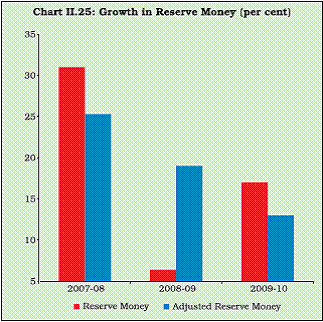 |
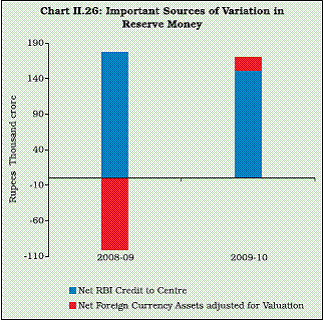 |
II.3.6 The expansion in net Reserve Bank credit
to the Centre in 2009-10 reflects the combined
effects of monetary operations conducted through
open market operations (OMO), including liquidity
adjustment facility (LAF) operations, and market
stabilisation scheme (MSS), besides the changes
in government’s cash balances with the Reserve
Bank. During 2009-10, about 57 per cent of the
increase in net Reserve Bank credit to the Centre
was on account of unwinding/de-sequestering of balances held under the MSS (Chart II.27)1. The
bulk of the decline in MSS balances occurred during
the first quarter of the year. Since April 2004, MSS
has been a key sterilisation instrument for dealing
with the liquidity impact of surges in capital inflows,
leading to accumulation of government deposits
which remained sterilised with the Reserve Bank.
In the liquidity augmenting response to the global
crisis, these MSS balances were released through
unwinding and de-sequestering.
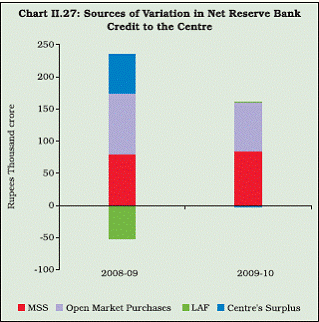 |
II.3.7 The other major driver of net Reserve Bank
credit to the Centre in 2009-10 was the open market
operations of the Bank, which accounted for 50 per
cent of the increase. The open market purchases
were mainly confined to the first half of the year,
which along with MSS unwinding, facilitated the
smooth conduct of the front-loaded government
borrowing programme for 2009-10. Even though
MSS unwinding and open market purchases
explain almost the entire annual variation in net
Reserve Bank credit to the Centre, other liquidity
impacting factors such as operations in the LAF market and changes in Centre’s cash surplus with
the Reserve Bank, were important drivers of
quarterly variations in liquidity in the system during
2009-10. Since July 28, 2010, there are no MSS
balances with the Reserve Bank; thus, the option
of liquidating the MSS balances to expand liquidity
and thereby to influence the growth in reserve
money has been exhausted.
II.3.8 The overall monetary conditions reflected
significant changes in the autonomous drivers of
liquidity as well as discretionary liquidity operations
of the Reserve Bank consistent with its monetary
policy stance. Notwithstanding differences in
country practices in interpreting autonomous
drivers of liquidity, in India, an appropriate indicator
could include the combined effects of: (i) Reserve
Bank’s net purchase of foreign exchange from
authorised dealers, (ii) currency with the public,
(iii) government’s surplus cash balances with the
Reserve Bank, besides WMA and overdrafts, and
(iv) others. In turn, the management of liquidity by
the Reserve Bank, which could be viewed as the
discretionary component of the system level
liquidity, include the liquidity impact of: (i) LAF
operations, (ii) net OMO, (iii) MSS, and (iv) the
first round impact of changes in CRR. The
aggregate outcome of variations in autonomous
and discretionary components of liquidity match
with the change in banks’ reserves (Chart II.28).
Detailed discussions on liquidity management
operations of the Reserve Bank are presented in
Chapter III.
Developments in 2010-11 so far
II.3.9 Reserve money continues to grow at an
accelerated pace in 2010-11 so far (August 13,
2010). The main component of increase in reserve
money is currency in circulation. The high growth
in currency (year-on-year growth of 20.1 per cent) is mainly on account of the spurt in inflation, low
deposit interest rates and also increase in vault
cash with banks.
Money Supply
II.3.10 Broad money (M3) growth decelerated for
the second successive year in 2009-10, reflecting
the moderation in demand associated with
deceleration in economic growth in relation to the
high growth achieved during 2003-08. On the
components side, the deceleration was mainly led
by slowdown in the growth of time deposits, partly
in response to softening of interest rates
observed during the year (Chart II.29) .
Accordingly, the share of time deposits in the
annual increment in M3 also declined (Chart II.30).
In 2008-09, however, time deposits exhibited
stronger growth due to depressed equity markets,
increase in risk perceptions and risk-free high
interest rates still available then on time deposits.
The expectation of subsequent decline in time
deposit rates had also motivated some shift from
demand deposits.
II.3.11 On the sources side, the share of banking
system’s credit to the government in the annual increase in M3 in 2008-09 and 2009-10 has been
one of the highest in recent years (Chart II.31). Net
foreign assets had a negative contribution to annual
variation in M3 in 2009-10 (Chart II.32).
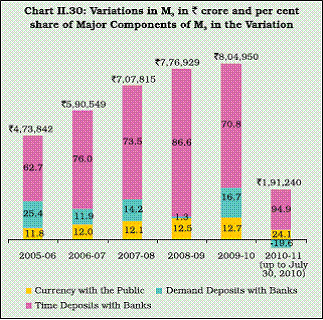 |
II.3.12 During 2009-10, the share of bank credit to
the commercial sector in the total net domestic
assets declined, as in the previous year. This was
mainly on account of the deceleration in the flow of non-food credit from November 2008 to October
2009 (Chart II.33). Non-food credit growth exhibited
deceleration till November 2009 and has steadily
increased thereafter, reflecting the improving
demand associated with a stronger industrial
recovery. The highest quarterly incremental flow
of non-food credit in two years was observed during the fourth quarter of 2009-10, reflecting the robust
increase in growth led by industrial production
(Chart II.34). Along with enhanced access to
alternative financing, monetary policy actions of the
Reserve Bank contributed to the recovery through
the normal transmission process in the credit
market, though with a lag (Box II.7).
Box II.7
The Credit Channel of Monetary Policy during the Recovery
The credit channel of monetary policy transmission received
significant attention in monetary policy debates during 2008-10,
as many advanced economies had to conduct policies in the
face of significant stress in credit markets. Monetary policy
transmission may completely break down in an environment of
“credit freeze”, since the liquidity injected by a central bank at
the lowest possible cost may not even reach the rest of the
economy. Even during normal market conditions, assessment
of the effectiveness of monetary policy could be a complex issue,
as monetary policy transmission mechanism can be equated to
a “black box” (Bernanke and Gertler, 1995). Central banks can
generally anchor the overnight interest rate around the policy
rates, but the transmission thereafter to real goal variables is
often uncertain and hazy. As noted by Blinder (1998), “...Central
banks generally control only the overnight interest rate, an interest
rate that is relevant to virtually no economically interesting
transaction. Monetary policy has important macroeconomic
effects only to the extent that it moves financial market prices
that really matter – like long-term interest rates, stock market
values and exchange rates”. Aggregate demand, thus, could be
influenced by changes in cost of capital, exchange rate and asset
prices, all of which could respond to changes in the policy rates.
Thus, by leveraging policy rate instrument, demand associated
with consumption of goods and services, housing, inventories
and investment could be influenced, though interest rate
sensitivity of demand may not be significant, particularly during
a recession or slowdown in economic activities. In such an
eventuality, assessment of the credit channel of transmission
mechanism could provide complementary information about the
effectiveness of monetary policy actions.
According to Bernanke and Gertler (1995), the two components
of the credit channel are the balance sheet channel and the banklending
channel. Borrowers often have the option to choose
between internal financing and external financing, and between
banks and non-banks with regard to external financing. Monetary
policy actions could alter the “external finance premium”, i.e.,
the difference between the cost of external funds and the
opportunity cost of internal funds. The external finance premium
exhibits an inverse relationship with the financial condition of
borrowers. The external finance premium gets influenced by
monetary policy actions through both balance sheet and bank
lending channels. Changes to cash flows and balance sheets
could have significant real effects. This became evident in
developed economies during the global crisis when not only the
balance sheets of banks contracted, but households and
corporates also experienced significant erosion in net worth and
faced uncertainty about cash flows. These developments altered
the financial conditions of borrowers, i.e., their creditworthiness,
which, in turn, would have affected their external finance premium.
The bank lending channel of monetary policy, which operates
through the supply of credit by deposit institutions (i.e., banks) to
bank-dependent borrowers, was also disrupted significantly in
these economies by the erosion in the capacity of banks to lend
due to pressure on their capital, besides reflecting significant
increase in risk aversion on the part of banks.
In India, unlike in advanced economies, the credit market
functioned normally and remained supportive of the recovery in
growth during 2009-10, notwithstanding the deceleration in the growth of non-food credit. The assessment of the bank credit
channel often encounters the challenge of disentangling the
demand side effects from the supply side effects. In India, neither
the banks’ capacity to lend was affected because of any pressure
on their capital, nor was there any intense deleveraging pressure
on the corporates and households that could have lowered the
demand for credit in a major way. The economic slowdown and
the associated deceleration in private consumption and
investment demand, however, led to moderation in demand for
non-food credit. Because of the monetary policy actions of the
Reserve Bank, primarily in the form of lower policy rates and
ample liquidity conditions, however, the constraint from the supply
side in the credit market was largely avoided. The bank lending
channel from the supply side may not be visible in broad trends
in the growth of non-food credit because of the simultaneous
and dominating influence of private consumption and investment
demand in depressing the demand for credit. Pandit et al. (2006)
found evidence of existence of bank lending channel for India,
even though several factors, including monetary policy shocks,
seemed to influence the lending behaviour of banks.
A standard four variable VAR (growth in GDP, growth in nonfood
credit, average lending rate and call rate), with necessary
diagnostic checks, validate the presence of conventional
monetary policy transmission in India for recent data, though
with larger error bands around the estimates. Increase in call
rates (induced by policy rate changes) lead to higher average
lending rates, with about two quarters lag, which in turn lower
the growth in non-food credit in the fifth quarter and the GDP
growth in the seventh quarter. This implies the sensitivity of
demand for credit to changes in lending rates. The moderation
in credit growth leads to lower growth in output. The estimated
impact, though, seems to be modest and tapers off gradually.
More importantly, the causality running from GDP growth to credit
growth turns out to be statistically significant, suggesting credit
following, rather than leading the pick-up in growth momentum.
This pattern needs to be seen in relation to increasing availability
of non-banking sources of funds, and their trends during the
recovery in 2009-10. Indian corporates have much greater
flexibility now in choosing between internal financing and
financing from banks and non-banks, which is evident from
significant year on year variations in the composition of their
liabilities. Aggregate level data also suggest that total financing
from non-banking sources were of a higher order than the flow
of credit from banks. Thus, trends in credit alone need not explain
the role of financial and liquidity conditions ensured by the
Reserve Bank in contributing to the recovery.
References
1. Bernanke, Ben S. and Mark Gertler (1995), “Inside the Black
Box: The Credit Channel of Monetary Policy Transmission”,
Journal of Economic Perspectives, Vol. 9, No. 4.
2. Blinder, A.S. (1998), Central Banking in Theory and Practice,
Cambridge, MIT Press.
3. Pandit, B. L., Ajit Mittal, Mohua Roy and Saibal Ghosh
(2006), “Transmission of Monetary Policy and the Bank
Lending Channel: Analysis and Evidence for India”, DRG
Study No. 25, Reserve Bank of India.
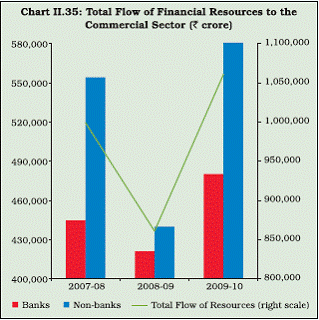 |
II.3.13 During the twelve month period beginning
November 2008 when bank credit, as conventionally
measured, was decelerating, the other investments
of banks (i.e., investment in shares/bonds/
debentures of corporates, commercial paper and
mutual funds) showed acceleration in the rate of
growth. As a result, indirect financing from banks
increased. The non-banking sources, both domestic
as well as foreign, meet a higher proportion of
funding needs of the commercial sector (Chart II.35).
The main sources of non-bank finance during the
period of deceleration in non-food credit were initial
public offers, private placements, issuance of
commercial papers, foreign direct investment and
American/Global depository receipts. While the total
flow of resources from banks and non-banks
increased during 2009-10, the flow of bank credit to
industry remained strong (Chart II.36).
Developments in 2010-11 so far
II.3.14 Money growth continued to decelerate
during 2010-11 so far owing to slowdown in the
growth rate of deposits. Banks have begun to
mobilise deposits by announcing hike in rates for
term deposits since end-July 2010. This has
become essential in order to meet the increased demand for credit from the commercial sector.
Though increased credit flow is yet to get broadbased,
there has been an improvement in credit
growth to personal loans and services in the recent
months. The flow of financial resources from the
non-banking sector also recorded a significant
increase during the first four months of 2010-11.
IV. FINANCIAL MARKETS
II.4.1 Financial markets functioned in an orderly
manner through 2009-10. As the overall liquidity
conditions remained in surplus, money market
interest rates generally stayed close to the lower
bound of the LAF rate corridor. The large market
borrowing by the Government put upward pressure
on the yields on government securities during
2009-10. However, this was contained by active
liquidity management by the Reserve Bank. Lower
credit demand by the private sector also helped in
containing the upward pressure on yield. Equity
markets generally remained firm during the year
with intermittent corrections in line with the global
pattern. Resource mobilisation through public
issues increased. Housing prices rebounded during
2009-10. According to the Reserve Bank’s survey,
they surpassed their pre-crisis peak levels in Mumbai.
The exchange rate exhibited greater flexibility.
II.4.2 Financial markets represent the medium
through which the impact of adverse global shocks
manifests first. The impact of the global crisis on
India was also visible first in the financial markets.
Thus, restoring normal conditions in the markets
became the key policy challenge to contain the
adverse impact on the real economy. The Reserve
Bank operated simultaneously in money, forex and
government securities markets, resorting to both
conventional and non-conventional measures,
which helped in restoring normalcy to market. This
in turn was critical for other macroeconomic
policies to be effective in managing the recovery
in 2009-10. Since India avoided a financial crisis
at home, the risk of stress in the financial system
constraining the recovery was also largely avoided.
As the financial institutions in India remained well
capitalised, it helped money and credit markets
to return to the pre-crisis trajectory at a faster pace.
However, in view of the significant uncertainties
prevailing in the global markets and the flow of
both positive and negative news at different points
of time during the course of the year, ensuring
normal functioning of market to support recovery
was critical.
II.4.3 Financial market developments tend to
pose two way complex and persistent challenges
to policy making: first, the uncertainty about how
adverse shocks transmit through the financial
markets to the real economy; second, how
monetary policy measures transmit through the
financial markets to attain the ultimate objectives
relating to the real economy. While Indian markets,
in particular the equity and forex markets, exhibited
volatility in response to adverse external news
relating to the developments in Dubai World and
Greece, the market trends were conditioned by the
domestic macroeconomic developments as well as
the policy stance of the Government and the
Reserve Bank.
International Financial Markets
II.4.4 Global financial market conditions
improved during 2009 despite the drag from the global financial crisis; although there were
phases of intermittent excess volatility. The
sovereign risk concerns, however, dominated the
financial markets towards the end of 2009 and
beginning of 2010, with the Dubai World debt
standstill and the sovereign debt problem of
Greece posing bouts of additional uncertainty to
the financial system. Beginning April 2010,
another shock to the global financial markets
emanated from the concerns of sovereign debt
problem spreading from Greece to other Euro
zone countries, that not only led to significant
depreciation of the euro and decline in stock
prices in the Euro zone but also transmitted
volatility to other financial markets across the
world (Chart II.37a to d). Reflecting flight to
safety, yields on government papers of the
advanced countries moderated. Credit Default
Swap (CDS) spreads of European countries with
fiscal imbalances rose, indicating the market
assessment regarding risks in these countries.
II.4.5 Reduction in risk perception towards EMEs
along with continuance of low policy rates in the
advanced economies for extended periods, led to
revival in capital flows, which in turn contributed
to increase in asset prices and also kept
appreciation pressures on the exchange rates of
EMEs. In India, both equity and foreign exchange
markets exhibited volatility in response to
developments in the global markets. Overall, the
transmission of global shocks to the real economy
remained contained. Stronger recovery in growth
also contributed to the improved confidence and
perceptions in the markets.
Domestic Financial Markets
II.4.6 The immediate response of the Reserve
Bank to the shocks from the financial crisis in the
advanced economies was in the form of provision
of ample domestic rupee liquidity and comfortable
forex liquidity. These were aimed at reducing
uncertainties stemming from perceptions of liquidity
scarcity and thereby restoring confidence in the
domestic money and forex markets. The direct transmission of shocks to India was through capital
outflows and excessive volatility in the exchange
rate, which warranted intervention by the Reserve
Bank to restore orderly conditions in the foreign
exchange market. Besides the actual intervention
sales in the foreign exchange market, the Reserve
Bank introduced the forex swap facility for the banks
and also took measures to improve specific inflows.
In order to address the apprehension of scarcity of
rupee liquidity in the banking system, the Reserve
Bank reduced CRR, unwound the MSS balance and
also deployed several other conventional and
unconventional measures. Within a short span
between October 2008 and April 2009, the repo
rate was lowered by 425 basis points which reduced
the cost of liquidity. As a result of these measures,
financial market conditions in India had recovered
quickly, after the initial impact of global shocks in
the second half of 2008-09.
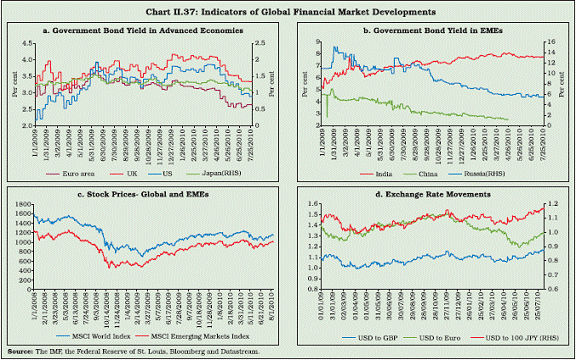 |
II.4.7 Swift and timely policy measures
undertaken by the Reserve Bank largely ensured faster normalisation of financial market conditions,
even though in the advanced economies prolonged
stress of financial systems affected the real economy
significantly in terms of lost output and employment.
Reserve Bank’s policy measures were critical for
two reasons. First, monetary policy had to ensure
that the various segments of financial markets
affected by the external shocks returned to normalcy
at the earliest so that the process of financial
intermediation could take place in a non-disruptive
manner to support the real sector. The provision of
ample liquidity along with a sound banking system
helped in faster normalisation in various segments
of domestic financial market. Second, monetary
policy had to take recourse to various measures in
order to mitigate the adverse effects of the global
shocks on the real sector. Normalisation of financial
market conditions were also essential for monetary
policy transmission to yield the intended results in
terms of averting a major slowdown in economic
activities and contributing to a faster recovery
thereafter. Despite considerable stability, the domestic financial markets faced the concerns
emerging from large fiscal deficit and the
inflationary expectations stemming from high
headline inflation in the second half of 2009-10.
Market Activities
II.4.8 The signs of improvement in financial
markets were reflected in reduction of risk
perception to pre-September 2008 level and return
of normal level of market activity in various
segments of the market. Ensuring adequate market
liquidity all through 2009-10 was considered
imperative to avoid pressure on short-term interest
rates and thereby facilitate recovery in growth.
Towards long end of the markets as well, risks
receded significantly as indicated by narrowing
spreads for 5-year AAA-rated corporate bonds. In
the equity market, the price volatility which had
declined in the earlier part of the year, increased
after the sovereign debt related concerns affected
the global markets (Chart II.38).
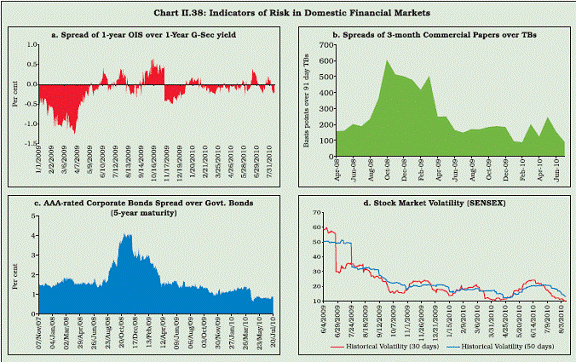 |
II.4.9 With the risk perception receding
significantly and market sentiments improving, all
segments of money markets bounced back to the
normal level of activity and even exceeded the precrisis
levels of turnover in some of the market
segments, which helped the financial entities and
corporates to raise resources for their working
capital requirements. The money market conditions
further improved during 2009-10. This was reflected
in the daily volumes in the money market, which
increased by 49 per cent. In the collateralised
segment, which continues to be the predominant
segment of the money market, over 75 per cent of
the lending was from mutual funds (MFs).
II.4.10 In the backdrop of persistent surplus
liquidity conditions, the average fortnightly
issuances of certificates of deposit (CD) increased
significantly and the liquidity in the market ensured
stable interest rates, with some uptick in the last
quarter of 2009-10. Issuance of commercial paper
(CP) also increased significantly. Despite significant pick up in issuances, interest rates on CPs
moderated, which helped corporates to finance
their working capital requirements during the
recovery. Turnover in government securities market,
which remained buoyant during 2009-10, declined
in the last quarter. Equity markets witnessed a
substantial rebound in activity due to strong
domestic recovery and improved external
conditions, with the turnover exceeding the precrisis
level. This helped corporates to raise
resources from capital markets through IPOs and private placements, which partly moderated the
demand for credit from the banking sources. Activity
in the foreign exchange markets, particularly the
merchant segment, was modulated by the pace of
recovery in capital flows and the subdued level of
foreign trade (Chart II.39).
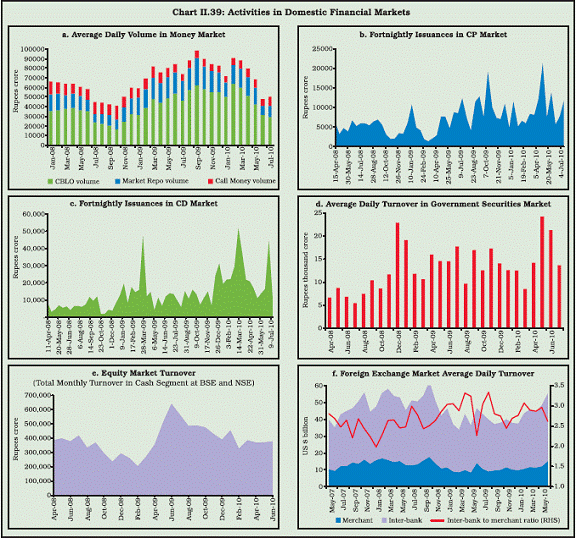 |
Financial Derivatives
II.4.11 Activity in financial derivatives, which was
adversely affected by the financial crisis, saw significant improvement in 2009-10, led by
adequate liquidity in the system and return of
stability in the domestic markets (Chart II.40).
Interest rate futures contracts on 10-year notional
coupon bearing government bond were introduced
on the National Stock Exchange on August 31,
2009. The market has, however, been unable to
sustain the liquidity and the open interest and
trading volumes have remained low. In the
Monetary Policy Statement for 2010-11, it has been
proposed to introduce interest rate futures on
5-year and 2-year notional coupon bearing
securities and 91-day treasury bills. The product
design and operational modalities for introduction
of these products are being worked out by the RBISEBI
Standing Technical Committee.
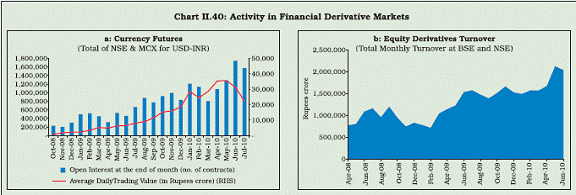 |
II.4.12 Interest rate swaps (IRS) were introduced
in July 1999 to allow banks, primary dealers and
all India financial institutions as well as corporates
to manage their interest rate risks in an
environment of deregulated interest rates. In the
Indian market, swaps are traded on four
benchmarks viz., MIBOR (Mumbai Inter-Bank
Offer Rate), MIFOR (Mumbai Inter-Bank Forward
Offer Rate), INBMK and MISOIS, though the first
two benchmarks i.e., MIBOR and MIFOR account
for most of the trades. The market has grown
significantly over the years; the gross notional
principal outstanding reached `80,18,647 crore2 in March 2008 and stood at ì42,82,452 crore as
at the end of April 2010.
II.4.13 The crisis seems to have somewhat
changed the perception towards financial
innovations. In India, comprehensive guidelines
were issued on derivatives in April 2007, intended
to safeguard the interests of the systems as well
as players in the market (Box II.8). The activity in
the derivative segment of equity market also
increased substantially during 2009-10, led by the
gains in stock prices and liquidity created by FII
inflows.
Monetary Policy Transmission through Financial
Markets
II.4.14 The transmission mechanism of monetary
policy to financial markets, which became a matter
of concern during the global financial crisis,
improved during 2009-10. Changes in policy rates
should normally translate into roughly similar
movements in market interest rates, particularly
at the short end. During the global financial crisis,
the repo rate in India were lowered by 425 basis
points between October 2008 and April 2009,
along with provision of ample liquidity. The rapid
transmission of lower policy rates to call rates was
evident in the decline in call money rates by about
700 basis points between October 2008 and April 2009, which also partly reflected shift in the LAF
mode to reverse repo, given the 150 basis points
width of the LAF corridor. During the same period,
the yield on 91-day TBs and CPs of same maturity
also declined more than the decline in key policy rates. Transmission of lower policy rates to even
long-term government bonds was significant, with
10-year bond yield declining by about 200 basis
points during the same period; however,
subsequently yields increased due to the concerns emanating from high government deficits and
rising inflation expectations.
Box II.8
Financial Innovations in India : Balancing the Goals of Growth and Stability
The global financial crisis of 2008 revealed that financial
innovations, though meant to hedge risks and help in efficient
price discovery, may be used for leverage and speculation,
thereby creating distorted incentives and exposing the
financial system to instability. While it may be difficult to judge
whether all financial innovations are good or bad, it is now
widely recognised that financial innovations should be pursued
in the broader context of financial stability and necessarily
correspond to the level of maturity of the financial system
and the needs of the real economy.
Balancing the need for innovations to spur economic growth
and avoiding innovations that could expose the financial
systems to systemic risks is a challenge on which no text
book solution is available as yet or even looks feasible. The
available analysis on the international experience relating
to the causal influence of financial innovations on economic
growth remains inconclusive. According to Turner (2010),
“…there does not appear to be any compelling proof that
increased financial innovation over the last 30 years in the
developed world has had a beneficial effect on output
growth…beyond some point, increased financial intensity,
may cease to deliver positive benefits or indeed have
negative effects”. There need not be anything wrong with
financial innovations per se; the risks ascribed to innovations
may actually be the result of inappropriate regulation, weak
information disclosure, or neglect of risk management. For
the EMEs, it is often suggested that they could introduce
products that are relatively simple, standardised, that offer
clear value addition and are easily understood by regulators,
buyers and sellers. In this context, Lipsky (2010) had viewed
that “…despite the current difficulties and challenges,
financial innovation will continue to play an important role in
raising growth globally, but especially in emerging markets
and developing countries. The current crisis can provide
important lessons as we move forward.”
The regulatory framework in India has always been alive to
the need for ensuring financial stability on an ongoing basis
while fostering growth supporting financial market
developments. One of the key factors that helped India to
counter the impact of the crisis was the counter-cyclical
regulatory environment and micro and macro prudential
measures. The banking regulation took due cognizance of
both the benefits and the complexity of the financial innovations. The extent of the adequacy of skill sets in the
financial system, both in the markets and institutions, was
also taken into consideration while evaluating the
implications of introducing new financial instruments. The
regulatory framework was extended to all the systemically
important financial institutions and a policy of identifying and
regulating conglomerates was adopted during recent years.
In India, in the last decade, apart from process innovations
that increased both the outreach and efficiency of the
financial sector, a series of financial innovations were
introduced in a phased manner. In the recent period, Reserve
Bank has introduced repo in corporate bonds and exchange
settled interest rate futures and currency futures/options in
various currencies. The Reserve Bank guidelines, however,
prohibit trading in structured synthetic derivative products
that may have another derivative as an underlying.
Introduction of credit derivatives in India was actively
examined in the past to provide the participants tools to
manage credit risk. An Internal Group was set up by the
Reserve Bank to finalise the operational framework for
introduction of CDS in India. The Group has noted that the
CDS market should be developed in a calibrated and orderly
fashion with focus on real sector linkages and emphasis on
creation of robust risk management architecture to deal with
various risks as have been evident in the recent financial
crisis. The Group has, inter alia, recommended that CDS
shall be permitted only on corporate bonds as reference
obligations, the reference entities shall be single legal
resident entities, users cannot purchase CDS without having
the underlying exposure and the protection can be bought
only to the extent of such underlying risk.
References
1. Lipsky, John (2010), “Managing Financial Innovation in
Emerging Markets,” Remarks at the Reserve Bank of
India First International Research Conference at Mumbai,
February 12.
2. Turner, Adair (2010), “After the Crises: Assessing the
Costs and Benefits of Financial Liberalisation”,
Fourteenth C. D. Deshmukh Memorial Lecture,
Reserve Bank of India, Mumbai, February 15.
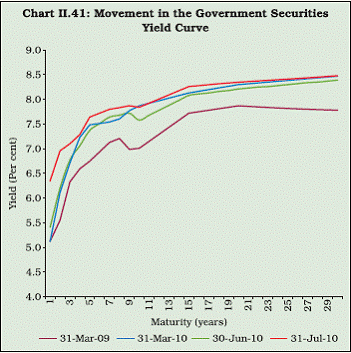 |
II.4.15 From the viewpoint of stability in interest
rates, fiscal consolidation became a major concern
for financial markets during 2009-10. While the
medium to long-term bond yields continuously
moved up during 2009-10, reflecting inflation and
fiscal deficit concerns, the short-term yield,
reflecting the surplus liquidity conditions, softened
till Q3 of 2009-10, followed by a hardening trend
in Q4 as the surplus liquidity moderated and
there was a reversal in the policy interest rate
cycle (Chart II.41). Lower fiscal deficit targets for
2010-11 in the Union Budget, however, paved the
way for stability to the medium to long-term yield
and to some extent also alleviated the concerns of
spillover of fiscal deficits to general interest rate
environment. During Q1 of 2010-11, the 10-year
yield again hardened on higher inflation data but
declined subsequently reflecting the higher-thanbudgeted
inflows from the 3G/BWA spectrum
auctions. Market expectations of inflation
moderating from the peak, expectations of an
increase in FII investment ceiling on government
debt, announcement of issue of short-term cash
management bills also contributed to the
moderation in yield.
II.4.16 The most important concerns that
dominated the credit markets were weak
transmission of policy rates to lending rates and
deceleration in the pace of credit growth. While the
credit growth continued to remain sluggish during
the first half of 2009-10, the stronger recovery in
GDP growth in the second half led to pick up in
demand for credit, indicating mainly the weakness
in demand rather than the supply constraint from
the banking system. Transmission of policy rates
to long-term lending rates of banks, however, was
relatively slow as compared with that in other
segments of the financial markets (Chart II.42).
II.4.17 A slower transmission to the credit market is
mainly suggestive of structural rigidities rather than
any crisis related impediments in the financial
markets. First, while headline inflation in terms of
wholesale price index (WPI) was lower, various
measures of consumer price inflation remained
elevated, which did not let inflation expectations to
moderate. Second, banks are typically cautious
about reducing deposit rates in response to the
central bank’s policy rate signals due to
apprehension of losing their deposit base to small
savings. The rates on small savings have not been
adjusted on a regular basis, particularly in response
to changes in the Reserve Bank’s policy rates. Third,
depositors enjoy an asymmetric contractual
relationship with banks. When interest rates are
rising, depositors have the option of withdrawing their
deposits prematurely and redepositing at the going
higher rate. On the contrary, when deposit rates are
falling, depositors would have incentive to continue
with the old deposits at a higher rate. This structural
rigidity clogs monetary transmission. Banks are
typically unable to adjust their lending rates swiftly
in response to policy signals until they are able to
adjust on the cost side by repricing the deposits.
Fourth, monetary transmission is also impeded
because of large government borrowings. Thus,
reflecting the structural character, bank lending rates
exhibited only gradual softening, thereby slowing
down the speed of transmission to credit markets.
The introduction of the base rate system for fixation
of lending rates by banks, which has come into effect from July 1, 2010, is expected to improve the
assessment of monetary policy transmission.
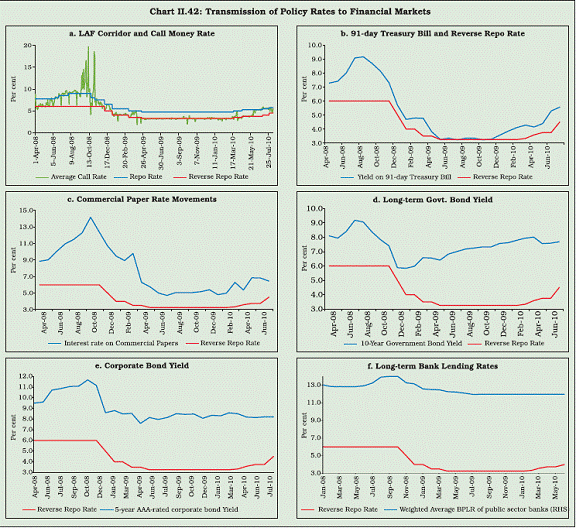 |
II.4.18 The base rate system gives complete
freedom to banks in their loan pricing decisions
while ensuring transparency. The base rates will
mirror the relative efficiency and cost structure.
While lending rates tend to be sticky, it is expected
that the base rate system will bring about greater
flexibility and strengthen both the interest rate and
credit channels of monetary transmission. It is expected to enhance the allocative efficiency of the
financial intermediation process by banks.
Deregulation of lending rates for loans up to `2 lakh
would enhance credit flow to agriculture and small
businesses.
II.4.19 While microfinance institutions (MFIs) have
been contributing to financial inclusion, the interest
rates charged by them on loans remain high. The
high interest rates essentially reflect their high costs
of borrowing and operational costs. There are 12 systemically important non-deposit NBFCs
(NBFCs-ND-SI) (with asset size over `100 crore)
classified as loan companies and registered with
the Reserve Bank, which are also engaged in
lending to the micro finance sector. Interest rates
levied by them on loans range from 23.6 per cent
to 30 per cent. Many of the scheduled commercial
banks, especially new private banks and foreign
banks have entered into arrangements with NBFCs
for outright buyouts and assignments of loans for
meeting their priority sector targets. However, the
ultimate beneficiary does not get the benefit of their
low rates of interest as these NBFCs are assigned
the responsibility of managing the loans by the
banks. Consequently, the borrower continues to
pay at the same rate. The main sources of funds
for these NBFCs are borrowings from banks and
financial institutions (including foreign financial
institutions). Most of them have received large
amounts as foreign direct investment and many of
them are now largely foreign owned.
Equity and Housing Prices
II.4.20 Aided by strong domestic recovery along
with resumption of FII inflows and ample market
liquidity, there was sharp increase in asset prices
in India, particularly equity prices. Stock prices
displayed a continuous upward momentum
throughout the year, except for some occasional
corrections caused by global financial market
shocks stemming from Dubai World default and the
Greek sovereign debt crisis (Chart II.43a and b).
During the phase of economic recovery, a sharp
increase in equity prices helped in improving the
investment climate and enabled corporates to raise
funds through IPOs and private placements.
Although housing prices witnessed correction
during the global financial crisis, there was a sharp
rebound in the subsequent period, broadly
coinciding with the rise in stock prices (Chart II.43c
and d). Greater pace of rise in asset prices
continued to remain a concern from the standpoint of macroeconomic management, notwithstanding
some moderation in Q4 of 2009-10. The higher asset
prices generally tend to fuel the demand pressure in
the economy and thus, contribute to inflationary
pressures. Their implications for the inflationary
process have, however, remained contained.
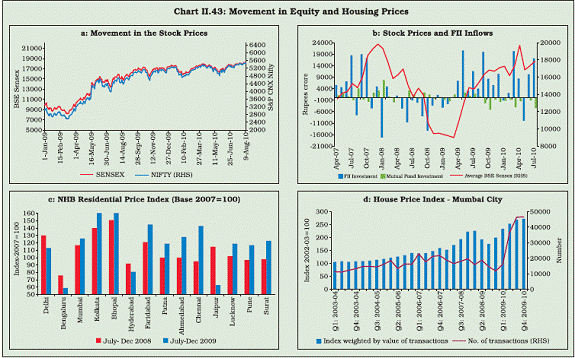 |
Exchange Rate
II.4.21 The importance of capital flows in
determining exchange rate movements leaves the
domestic foreign exchange markets susceptible to
international capital flows. In India, capital flows
have been a dominant source of volatility for not
only the exchange rate but also other market
segments. When FII investors exit from equity and
securities market abruptly in a herd, stock and bond
prices get affected, and when investors take the
redemption proceeds out of the country, the
exchange rate is affected. Reserve Bank’s foreign
exchange market operations to contain exchange
rate volatility, in turn, could tighten domestic liquidity
and thereby affect money market. Since capital
flows are sensitive to both global developments as
well as domestic fundamentals, at times the
domestic financial markets may be solely driven
by capital flows. Thus, the risk of adverse external
shock transmitting through financial markets will
have to be recognised and managed timely.
II.4.22 During 2009-10, on the back of short-term
capital inflows and positive growth outlook, rupee
generally appreciated against the US dollar, though marked by intermittent depreciation pressures. An
easy supply situation in the market on the back of
revival in capital flows also led to moderation in
forward premia. Importantly, even though capital
inflows were not excessive in relation to the
financing gap in the current account, the exchange
rate appreciated, reflecting the flexibility of the
exchange rate. With the onset of the Greek debt
crisis and the associated flight from euro to dollar
assets, the rupee depreciated against the US dollar
and the forex market witnessed increased volatility
(Chart II.44).
II.4.23 Despite increasing global market
uncertainties emanating from the Euro zone fiscal
sustainability concerns, domestic markets
functioned normally in 2010-11 so far, though with
higher volatility in some segments. Domestic equity
prices witnessed correction, albeit with some gains
in July 2010. The exchange rate depreciated due
to rising pressure on the euro and volatility in FII
flows. Domestic money markets faced liquidity
pressures, leading to hardening of short-term
money market rates. Responding to these
developments, the Reserve Bank initiated
temporary liquidity facilities that helped contain
inter-bank call rate around the ceiling of the LAF
corridor. Medium to long-term interest rates,
however, moderated on expectations of lower fiscal
deficit of the Government and general safe haven
appeal of government bonds. The primary segment
of the domestic capital market exhibited larger
mobilisation of resources in Q1 of 2010-11.
V. GOVERNMENT FINANCES
II.5.1 The extraordinary fiscal stance adopted
during 2008-09 by the government in response to
the global crisis had to be sustained during
2009-10 in order to support the recovery in growth.
As a result, the revenue deficit (RD) and gross fiscal
deficit (GFD) as percentage of GDP were budgeted
to increase further from the already high levels in
2008-09. In the revised estimates for 2009-10, RD
and GFD turned out to be even higher than the
budget estimates due to shortfall in revenues and
increase in non-plan expenditure in relation to
budget estimates. Provisional data for 2009-10
available subsequently also corroborate the
similar trend.
II.5.2 Sluggish growth in revenue receipts
resulted from the discretionary stimulus measures
by way of cuts in indirect tax rates as well as the
negative impact of economic slowdown on revenue.
Some of the fiscal measures aimed at containing
inflation also contributed to expansion in the size
of deficits. Even though growth in total expenditure
decelerated markedly due to lower growth of
revenue expenditure, capital expenditure was
stepped up significantly. For the deficit levels to
return to the pre-crisis zone of consolidation, and
thereby contribute to the high and sustainable
growth in the medium-term, credible action plans
on fiscal exit had become critical by the end of the
year. Accordingly, the Union Budget for 2010-11
outlined the steps towards the beginning of fiscal
exit (Chart II.45).
Fiscal Stance During 2009-10
II.5.3 In sustaining the expansionary stance to
stimulate the economy, while expenditure
measures continued to dominate, stimulus through
tax cuts increased during 2009-10. Expenditure on
various social sector projects such as under the
National Rural Employment Guarantee Act
(NREGA) increased significantly and the
permanent impact of the Sixth Pay Commission
award on income also helped in containing the rate
of deceleration in private consumption demand.
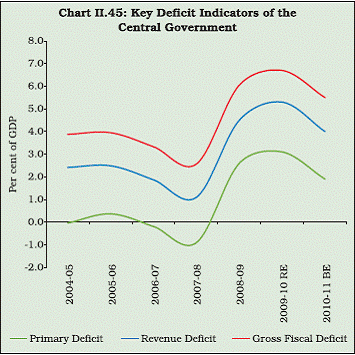 |
Accordingly, total expenditure as percentage of
GDP increased by 0.5 percentage point during
2009-10 over the previous year. The government
also extended the reduction in excise duty rates by
4 percentage point effective from December 7, 2008
to the fiscal 2009-10, besides further reducing the
general rate of central excise duty from 10 per cent
to 8 per cent and services tax rate from 12 per cent
to 10 per cent. These steps were taken despite
further widening of RD and GFD to alleviate the
inflationary impact of global price rise as well as to
boost aggregate demand. Reflecting these
measures, as percentage of GDP, net tax revenue
declined by 0.5 percentage point (Chart II.46).
II.5.4 During 2009-10, fiscal stimulus measures
as per cent of GDP moderated to 1.8 per cent from
2.4 per cent in 2008-09. Moreover, qualitative
improvement in the composition of fiscal stimulus
was also evident during 2009-10. Expenditure was
better targeted to spur aggregate demand and to
add to the capacity creation through increased
focus on social and physical infrastructure. Hence,
capital expenditure increased by about 28 per cent
vis-a-vis 14 per cent rise in revenue expenditure
during 2009-10. In adopting an expansionary
stance on the expenditure side, the allocation
between revenue and capital expenditure has to be seen in relation to the choice between what type
of expenditure would spur growth with limited lag
and what type of expenditure may involve a larger
lag but exert less pressure on medium-term fiscal
sustainability. Capital expenditure, unlike revenue
expenditure, is expected to create cash flows in
future, which in turn, would service the debt that
would have financed the capital expenditure.
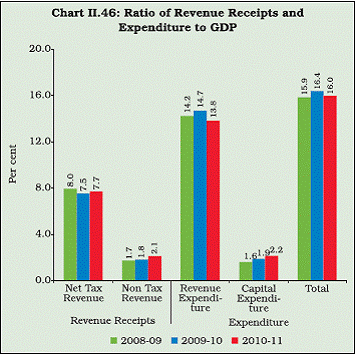 |
II.5.5 Capital expenditure in the revised
estimates of 2009-10 fell short of the envisaged
level by 6.8 per cent, due to the non-plan
component, which fell short by 16.2 per cent.
There was a corresponding revenue expenditure overrun by 1.0 per cent, as revenue expenditure
was higher by 3.7 per cent than the budget
estimates, owing to overruns in salary, pension
and subsidies (Chart II.47).
II.5.6 The increase in salary expenditure was over
and above the payment of arrears from Sixth Pay
Commission awards, which were part of the budget
estimates. Though these additional expenditures
were not strictly a part of deliberate steps taken to
spur recovery in growth, given the timing and
quantum, they effectively worked as stimulus to the
economy during 2009-10. On the non-plan
expenditure side, higher interest payments were
primarily a reflection of the higher borrowings in
the previous year, and not necessarily part of
stimulus measures. Such expenditure may have to
be seen as the cost of past stimulus rather than
stimulus in itself.
Fiscal Correction and Consolidation
II.5.7 The extraordinary fiscal stance adopted
during 2008-09 and 2009-10, to a large extent,
achieved the short-term objective of containing the
economic slowdown and stimulating the economy
thereafter. As the prospects of sustained economic
recovery became increasingly evident during the
course of 2009-10, the central government
announced a gradual fiscal exit plan in the Union
Budget for 2010-11. It aimed to bring down RD and
GFD during 2010-11 through a combination of
substantial increase in revenue receipts by 18.1 per cent and non-debt capital receipts by 54.0 per cent,
while containing the growth in revenue expenditure
to 5.8 per cent (Chart II.48). The robust growth in
revenue receipts is premised on partial rollback of
indirect taxes, anticipated revenue buoyancy from
stronger growth and 3G/BWA spectrum auction
proceeds. Revenue expenditure is expected to
moderate on account of freezing the non-plan
component almost to the level of the previous year,
while capital expenditure has been budgeted to
grow at 30.2 per cent during 2010-11. These
measures planned for 2010-11 indicate both
beginning of fiscal exit as well as emphasis on the
quality of fiscal adjustment. Along with these, the
Medium Term Fiscal Policy Statement (MTFPS)
also offers a medium term fiscal consolidation path,
in terms of rolling targets for key parameters of fiscal
consolidation. RD and GFD have been planned to
be brought down to 2.7 per cent and 4.1 per cent
of GDP, respectively, by 2012-13.
 |
II.5.8 The quality of fiscal adjustment and the
possibility of attaining the extent of consolidation
as per the envisaged plan in the short to mediumterm
will be critically important to contain the fiscal
risks to the medium-term macroeconomic outlook.
The fiscal correction envisaged during 2010-11
seems to rely significantly on one-off items of expenditures and receipts. Excluding one-off items
such as arrears payments and farm debt waiver
from the expenditure side, and disinvestment and
3G/BWA spectrum auction proceeds from the
receipts side, RD and GFD will show a correction
of 0.5 and 0.3 percentage points of GDP over the
previous year, respectively, as against 1.3 and 1.2
percentage points reduction envisaged in the
Budget (Chart II.49). A substantial portion of the
higher collections under 3G/BWA auctions would
be preempted by the net cash outgo of around
`54,589 crore on account of the first batch of
Supplementary Demands for grants for 2010-11
that were recently tabled in Parliament. Durable
fiscal consolidation, however, would require
correction on the recurring components of
expenditure and receipts, and less reliance on oneoff
items, as these options may not be available
every year.
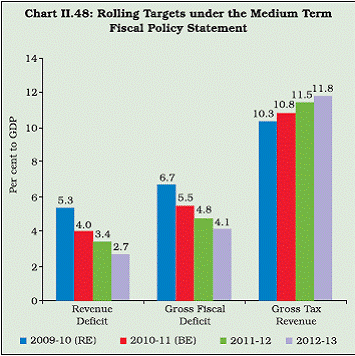 |
II.5.9 The adjustment in RD as indicated in
MTFPS also falls far short of the Thirteenth Finance
Commission’s (ThFC) recommendation to remove
revenue deficit by 2013-14, which the government
has accepted in principle. Going forward, it is amply
evident that all the required adjustments in revenue/
fiscal deficit over the next three to four years cannot
be achieved through tax reforms envisaged under the Direct Tax Code (DTC) and the Goods and
Services Tax (GST). In the MTFPS, the incremental
gross tax revenue to GDP ratio resulting from these
tax reform measures is estimated to be 0.7
percentage points of GDP during 2011-12 and 0.3
percentage points during 2012-13. This is much
lower than the minimum corrections required to
bring down the revenue deficit to zero. Therefore,
besides tax reforms, expenditure reforms in terms
of prioritisation and rationalisation would be crucial.
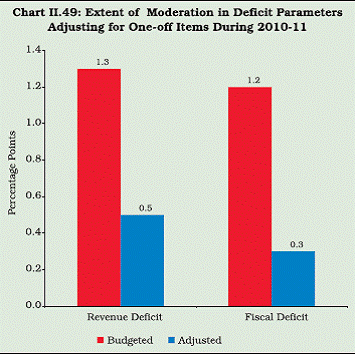 |
II.5.10 On expenditure reforms, the Budget for
2010-11 attempted to curtail the growth of non-plan
expenditure, primarily through cuts in explicit
subsidies, particularly petroleum and fertiliser
subsidy, while no liabilities (through the issue of
bonds) will be created in lieu of these subsidies.
However, the quantum of these two subsidies will
depend upon the movement in international prices
of these two commodities. Reflecting partial
acceptance of the recommendations of the “Expert
Group on a Viable and Sustainable System of
Pricing of Petroleum Products” (Chairman: Prof.
Kirit Parikh), price of petrol was deregulated and
other products were revised upwards in June 2010,
which will contain the fiscal pressure arising from
the under recoveries by the public sector oil
companies. While in the near term the inflationary
pressures could increase, improved fiscal position
will generally help in the management of inflation.
The revisions effected in June 2010, however,
would only reduce the size of the expected underrecoveries
during 2010-11 by one third.
II.5.11 On the revenue side, given the projected
gross tax revenue growth of 17.9 per cent and
nominal GDP growth of 12.5 per cent during 2010-
11 in the Budget, the implied tax buoyancy is
estimated to be 1.43. This is lower than the average
buoyancy of 1.60 observed during the high growth
phase of 2003-2008. Direct tax collections, which
generally exhibit a pro-cyclical pattern, should
improve once the growth momentum picks up.
Furthermore, the implementation of new Direct Tax
Code is expected to boost the direct tax collections.
As for indirect taxes, the likely implementation of
goods and services taxes is expected to revert the effect of tax rate cuts. It will also bring into the tax
net the untapped segments of the service sector,
which is growing rapidly. As a consequence, the
MTFPS 2010-11 projects the tax-GDP ratio to
increase to 11.5 per cent and 11.8 per cent in 2011-
12 and 2012-13, respectively.
State Finances
II.5.12 During the period before the crisis, there
was considerable improvement in consolidated
fiscal position of the state governments as reflected
in major deficit indicators, viz., revenue deficit (RD),
gross fiscal deficit (GFD) and primary deficit (PD)
as percentage of GDP (Chart II.50). Improved
revenue receipts during the high growth phase and
the responses of states to the incentives given by
the Twelfth Finance Commission (TwFC) to
implement their own fiscal responsibility legislations
(FRLs) in the form of conditional debt restructuring
and interest rate relief largely contributed to this
progress. Since 2008-09, progress on fiscal
consolidation has been interrupted because of the
impact of the slowdown in growth on revenues and
the implementation of the Sixth Central/State Pay
Commissions on expenditures. All major deficit
indicators exhibited some increase during 2008-09
and 2009-10, reflecting the combined effects of lower revenue realisation and higher expenditure
commitments.
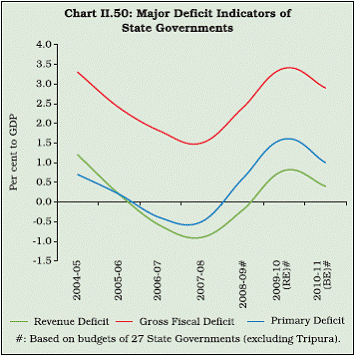 |
II.5.13 The impact of the slowdown in growth on
state finances was much more visible in 2009-10
(RE) over 2009-10 (BE) mainly on account of lower
growth in revenue receipts. Both own tax revenue
as well as states’ share in central taxes were lower
than budget estimates for 2009-10. Revenue
expenditure, however, recorded a marginal
increase over budget estimates in 2009-10. In
addition to deterioration in the revenue account,
decline in non-debt capital receipts also contributed
to higher GFD-GDP ratio in 2009-10 (RE) over
2009-10 (BE), even though capital outlay by state
governments declined.
II.5.14 The overall fiscal position of states is
budgeted to improve during 2010-11. Consolidated
revenue deficit to GDP ratio of 27 states has been
budgeted to decline from 0.8 per cent in 2009-10
(RE) to 0.4 per cent in 2010-11, while GFD-GDP
ratio is budgeted lower at 2.9 per cent in 2010-11
as compared with 3.4 per cent in 2009-10 (RE).
Besides improvement in revenue account, lower
GFD-GDP ratio is expected to be mainly on account
of lower growth in capital outlay in 2010-11 (BE). It
is also expected that the larger devolution to the
states due to the recommendations of the
Thirteenth Finance Commission would aid the
states to consolidate their finances further and
move to the fiscal reform path as envisaged by the
Commission (Box II.9).
Box II.9
Major Recommendations of the Thirteenth Finance Commission
A major factor which would shape finances of the states
in the medium-term is the implementation of the
recommendations of the Thirteenth Finance Commission
(ThFC). Major recommendations of the ThFC are:
Devolution
-
The share of states in net proceeds of shareable
Central taxes is recommended at 32 per cent for 2010-
11 to 2014-15 compared to the existing level of 30.5
per cent.
-
The share of grants in the total transfer has come down
from 18.9 per cent as recommended by Twelth Finance
Commission (TwFC) to 15.1 per cent (excluding state
specific grants) in the case of ThFC.
-
The indicative ceiling on overall transfers to states on
the revenue account is set at 39.5 per cent of gross
revenue receipts of the centre as compared to 38 per
cent by the TwFC.
-
On the implementation of GST, the ThFC
recommended that the centre and the states should
conclude a ‘Grand Bargain’ of Rs.50,000 crore to
implement the Model GST.
-
The Commission has recommended total grant for the
local bodies of Rs. 87,519 crore over the award period.
The Commission has also recommended distribution
of the grants between urban and rural areas and the
inter se distribution between states.
Fiscal Roadmap
- Revenue deficit (RD) to be eliminated by 2011-12 for
those states that attained revenue surplus in 2007-08. Other states should eliminate revenue deficit by 2014-15. States should accordingly modify/enact their
respective Fiscal Responsibility Legislations.
-
The general category states that attained a zero
revenue deficit or a revenue surplus in 2007-08 should
achieve a fiscal deficit of 3 per cent of GSDP by 2011-
12 and maintain it thereafter. Other general category
states need to achieve gross fiscal deficit of 3 per cent
by 2013-14.
-
All special category states with base fiscal deficit of
less than 3 per cent of GSDP in 2007-08 could incur a
fiscal deficit of 3 per cent in 2011-12 and maintain it
thereafter. For Jammu & Kashmir and Mizoram,
however, the terminal year would be 2014-15 and for
other special category states, the terminal year is
2013-14.
-
Combined debt of centre and states to decline to 68 per
cent of GDP by 2014-15 (45 per cent for centre and less
than 25 per cent for States) from 82 per cent in 2009-10.
-
The Ministry of Finance (GoI) should work out the
borrowing limits for prescribed fiscal reform path.
-
The FRBM Act needs to specify the nature of shocks
that would require a relaxation of FRBM targets.
-
An independent review mechanism to be set up by
the centre to evaluate its fiscal reform path which
should evolve into a fiscal council with legislative
backing over time.
-
Apart from the above, ThFC also recommended a Debt
Relief Scheme for the states including NSSF in its ambit.
Combined Finances
II.5.15 Reflecting the expansionary fiscal stance
of the central and state governments, their
combined RD and GFD as percentage of GDP
increased further during 2009-10 (Chart II.51). The
growth in total expenditure decelerated sharply
due to containment of revenue expenditure. The
total combined expenditure to GDP ratio, however,
increased from the previous year, while the
revenue receipts to GDP ratio remained more or
less unchanged, resulting in further enlargement
of all the key deficit indicators.
II.5.16 With the envisaged fiscal consolidation by
the central and the state governments during 2010-
11, there could be substantial improvement in the
combined finances. The combined RD and GFD as
percentage of GDP are budgeted to decline during
2010-11 (Chart II.52). The envisaged fiscal
consolidation has been planned to be driven by
significant increase in revenue receipts while
curtailing the growth of expenditure.
Fiscal Dominance and Macroeconomic
Conditions
II.5.17 Persistent large fiscal deficit has several
adverse macroeconomic risks ranging from higher inflation, to lower savings, crowding-out pressures
on private investment, decline in potential output,
and worsening of external imbalances. While these
concerns may be absent in the short-term in a
phase of economic slowdown that requires the use
of fiscal stimulus, in the medium-term these risks
may materialise if the fiscal deficit is not brought
down significantly under a credible fiscal
consolidation strategy.
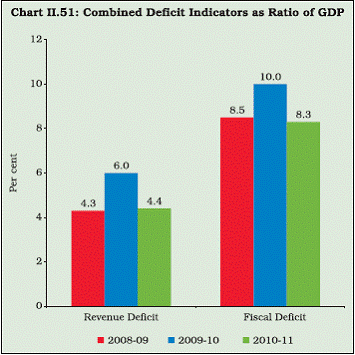 |
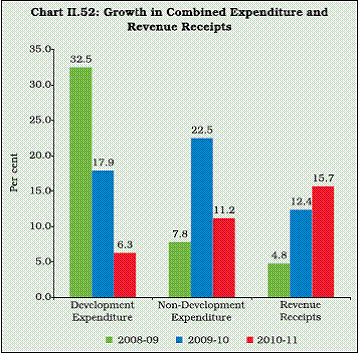 |
II.5.18 Risks to inflation from the higher levels of
fiscal deficit in India resulting from fiscal stimulus
measures during 2008-09 and 2009-10 remained
contained till the first half of 2009-10, due to the
following reasons: (i) the fiscal stimulus, rather than
creating any excess demand, partially offset the
deceleration in private consumption and investment
demand, (ii) the fiscal stance and resultant
financing of large borrowing programme did not
cause any overshooting of money growth since
private sector demand for credit remained subdued,
and (iii) certain indirect tax rate cut measures led
to lowering the prices of goods and services to
some extent even though these measures yielded
higher deficits. Rising and generalised inflation with
increasing demand side pressures in the second
half of 2009-10 suggested the need for timely fiscal
exit to contain any fiscal risks to inflation.
II.5.19 Notwithstanding the absence of near-term
risks to inflation from the fiscal conditions, however,
there could be medium-term inflationary
implications in the absence of a well designed fiscal
exit in terms of timing and pace. Empirical evidence
shows that even after the complete phasing out of
automatic monetisation of government deficit in
1997, fiscal deficit still entails risks to the inflation path in India, in the medium to long-run. These risks
to inflation from large fiscal deficit arise either through
direct impact on aggregate demand or monetary
expansion or a combination of both (Box II.10).
II.5.20 A fiscal deficit that emerges on account of
revenue imbalance directly lowers the savings rate
in the economy, as revenue imbalance amounts to dis-savings of the government. There is no
automatic mechanism that can raise the savings
of households and corporates when dis-savings of
the government rise. As a result, the overall saving
rate of the economy may decline, which was evident
in 2008-09 in the savings data. With the decline in
combined revenue and fiscal deficit during 2003-
04 to 2007-08 under the FRBM/FRLs, public sector
saving had improved, which was an important
contributing factor behind the increase in overall
saving and investment rate that propelled the high
GDP growth, during that period. The higher GDP,
in turn, facilitated reduction in revenue deficit of
the government, by improving revenue buoyancy,
thereby creating a virtuous cycle. But, with the
significant jump in the revenue deficit of the
government during 2008-09 and 2009-10, the
overall savings and consequently investment rates
have also dipped correspondingly (Chart II.53).
Box II.10
Fiscal Dominance and Risks to Inflation in India
In the developing countries context, inflation, at times, may
become effectively a fiscal phenomenon, since the fiscal
stance could significantly influence the overall monetary
conditions due to fiscal dominance. Sargent and Wallace
(1981) viewed that fiscally dominant governments running
persistent deficits would sooner or later finance those
deficits through creation of money, which will have
inflationary consequences. Fischer and Easterly (1990)
argued that rapid monetary growth may often be driven
by underlying fiscal imbalances, implying that rapid
inflation is almost always a fiscal phenomenon.
In the Indian context also, several studies have shown that
due to fiscal dominance there exists a nexus between
government deficits, money supply and inflation, which
may lead to a self perpetuating process of deficit-induced
inflation and inflation-induced deficit (Sarma, 1982,
Jadhav, 1994 and Rangarajan and Mohanty, 1998). Even
after the complete phasing out of automatic monetisation
of deficit in 1997, government deficit continued to be a
key factor causing incremental growth in reserve money
on the sources side, and overall expansion in money
supply and inflation (Khundrakpam and Goyal, 2009).
The long-term inflationary potential of fiscal deficit could be
analysed by hypothesising that either: (i) there can be a
direct impact on inflation through increase in aggregate
demand; or (ii) indirectly through money creation or
seigniorage; or (iii) a combination of both. The cointegrating
long-run relationships estimated through ARDL approach
during 1952 to 2009 reveals the following: (i) government
resorts to seigniorage to finance its deficit in the long-run;
(ii) resorting to seigniorage by the government influences
the price level; (iii) government deficit also has direct causal
impact on the price level. In other words, ceteris paribus,
price level in the economy in India, in the long-run, is
influenced either directly by deficit itself or through the creation
of money via deficit financing, or a combination of both.
One per cent change in fiscal deficit is estimated to cause
half a per cent change in seigniorage ‘S’, defined as
change in real reserve money :
Log S = -3.19 + 0.51 Log GFD - Dummy1975-76
-(10.7) (16.6) (-2.8)
One per cent change in seigniorage is estimated to cause
about one-third of a per cent change in the price level :
Log WPI = 4.53 + 0.32 Log S + 0.05 Trend
(17.6) (1.7) (4.0)
One per cent change in fiscal deficit is estimated to cause
about one-quarter of a per cent change in the price level:
Log WPI =3.0 + 0.25 Log GFD + 0.044 Trend + Dummy 1974-75
(5.1) (2.1) (2.9) (2.6)
In the short-run, the inflationary impact of seigniorage is
found to be negligible, though one per cent increase in fiscal
deficit still shows positive impact of about 0.04 percentage
point on the price level. The risks to inflation path should be
an important driving motivation behind early fiscal exit.
References
1. Fischer, S. and W. Easterly (1990), “The Economics
of the Government Budget Constraint”, World Bank
Research Observer 5, No. 3.
2. Jadhav, N. (1994), Monetary Economics for India,
Delhi, Macmillan India Limited.
3. Khundrakpam J. and R. Goyal (2009), “Is Government
Deficit in India Still Relevant for Stabilisation”, Reserve
Bank of India Occasional Papers, Vol.29, No. 3.
4. Rangarajan, C., and Mohanty M.S. (1998), “Fiscal
Deficit, External Balance and Monetary Growth”,
Reserve Bank of India Occasional Papers, Vol. 18,
No. 3.
5. Sarma, Y.S.R. (1982), “Government Deficits, Money
Supply and Inflation in India”, Reserve Bank of India
Occasional Papers, Vol. 3, No. 1.
6. Sargent, Thomas J. and Neil Wallace (1981), “Some
Unpleasant Monetarist Arithmetic”, Federal Reserve
Bank of Minneapolis Quarterly Review, Vol. 5, No. 3.
II.5.21 A lower savings rate can affect the potential
output path not only by depressing the investment
rate but also through altered resource allocation
because of the competition for resources between
public sector and the private sector. The crowdingout
possibilities could arise because of direct preemption
of loanable funds in the economy by the government for financing deficit or, indirectly,
through rise in real interest rates, or a combination
of both. Empirical evidence on crowding-out in
India, however, is ambiguous (Box II.11).
Notwithstanding the contradictory evidence, the
crowding-out impact generally remains moderate
when fiscal policy behaves contra-cyclically. During
1991 to 2009, there is some evidence of fiscal policy
stance being contra-cyclical in the sense that fiscal deficit as a ratio to GDP declined during the period
when output was above trend and vice versa. In
other words, there was a negative correlation
between output-gap and fiscal deficit. However, the
bidirectional causality results suggest that fiscal
policy not only tended to follow a countercyclical
behaviour, but was also influenced by the business
cycle in a fashion that could be viewed similar to
activation of automatic stabilisers.
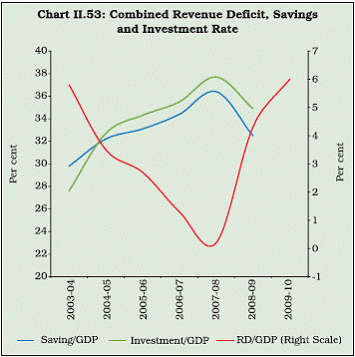 |
Box II.11
Crowding-Out Concerns: What the Empirical Evidence Suggests?
With stronger signs of recovery by the end of the year,
and gradual pick-up in demand for credit from the private
sector, the usual crowding out concerns associated with
sustained large fiscal deficits had to be recognised in the
calibrated approach to unwinding of the monetary policy.
While the inflationary conditions warranted monetary
tightening, appropriate liquidity conditions had to be
ensured to meet the demands of a large borrowing
programme as well as recovering demand for credit from
the private sector.
A review of some of the available literature in India reveals
that the empirical evidence on crowding-out of the private
sector by the public sector is not unambiguous.
Chakraborty (2007) found no evidence of public investment
crowding out private capital formation in India for the period
1971 to 2003. In fact, public infrastructure investment
complemented private corporate investment. Further, there
was also no evidence of fiscal deficit crowding out private capital formation through increase in real interest rate
during the same period. Three possible reasons for no
crowding could be: (i) pattern of household savings shifting
towards financial assets and thereby raising the available
loanable funds in the economy, (ii) private corporates
increasingly raising resources through capital markets,
besides availing bank credit, which indicates that private
sector did not face a constraint from credit being affected
by crowding out pressures, and (iii) overall liquidity in the
system might have increased, which has and prevented
pushing up interest rates.
Mitra (2006) analysing the relationship between
government investment, private investment, and gross
domestic product during the period of 1969 to 2005 found
that government investment crowds-out private
investment. The resources consumed by the government
would have been more effective in the hands of the private sector. Thus, too much government investment obstructed
the path of India’s economic growth.
Crowding out impact could largely depend upon the nature
of the public sector expenditure (RBI, 2002). Public sector
consumption to boost aggregate demand in the economy
crowds-out private consumption. Even for public sector
investment, only infrastructure investment crowds-in
private investment. Enlarged fiscal deficit crowds-out
private investment, and therefore, the crowding in impact
of public infrastructure investment will be lesser if financed
by larger fiscal deficit. Thus, the government needs to
restructure the composition of its expenditure towards
infrastructure while containing fiscal deficit to have the
maximum impact on growth.
An analysis using the trends in output gap, computed as
actual minus trend growth using Hodrick-Prescott filter,
and fiscal deficit (as percentage of GDP) during 1990s
and 2000s reveal the following. When the output-gap was
negative (i.e., there was excess capacity) during 1997-
2002, fiscal deficit enlarged, while it declined during
1993-97 and 2004-08 when output gap was positive (i.e.,
there was over-utilisation of capacity). This inverse
pattern observed in the past between output gap and
fiscal deficit could indicate either countercyclical fiscal
policy response or the result of impact of automatic
stabilisers or a combination of both. VAR Granger
Causality tests between output gap and fiscal deficit
during 1990-91 to 2008-09 also reveal bidirectional
causality between the two (Table A).
Table A: Output Gap and Gross Fiscal Deficit : VAR Granger Causality |
Null Hypothesis |
Chi-sq |
Probability |
Output-gap does not Granger Cause Δ GFD |
3.43 |
0.06 |
Δ GFD does not Granger Cause output-gap |
5.99 |
0.01 |
Thus, the crowding out concerns have to be seen in
relation to different phases of the business cycle. During
a recession or slowdown in growth, countercyclical fiscal
policy and the resultant increase in fiscal deficit may
contribute to recovery. In turn, during high growth, fiscal
deficit may moderate through revenue buoyancy.
However, if fiscal deficit remains high during a high growth
phase, that could create crowding-out risks.
References
1. Chakraborty, Lekha S. (2007), “Fiscal Deficit, Capital
Formation, and Crowding Out in India: Evidence from
an Asymmetric VAR Model” Working Paper No.518,
The Levy Economics Institute.
2. Reserve Bank of India (2002), Report on Currency
and Finance 2000-01.
3.Mitra, P. (2006) Has Government Investment
Crowded-Out Private Investment in India?
http://
www.aeaweb.org/annual_mtg_papers/2006/
0108_1015_0102.
II.5.22 Besides the concerns relation to crowdingout
pressures and inflation, fiscal imbalances also
entails the risk of widening the current account
deficit. Due to the dominant role of remittances in
moderating the magnitude of current account
imbalances, the twin deficit concerns often ascribed
to fiscal deficit do not materialise in India. The
imbalance between exports and imports (of goods
and services) as percentage of GDP, however,
seem to validate the pressure that fiscal situation can exert on the country’s external balance situation
(Chart II.54).
VI. EXTERNAL SECTOR
II.6.1 In a globalised world, a congenial global
economic environment and a sustainable balance
of payments position are critical for achieving the
policy goal of stable growth. The global recession
in 2009 operated as a dampener on the prospects
of a faster recovery. Besides the conventional
channels of trade and capital flows for transmission
of external shocks to the domestic real economy,
the uncertainty about global recovery continued to
affect business confidence and market sentiments,
which indirectly affected domestic private
consumption and investment demand. India’s high
degree of resilience and capacity to manage a severe
external shock was evident from the strength and
pace of recovery in GDP growth during 2009-10.
II.6.2 In 2009, the global economy not only
experienced a ‘great contraction’, but there was
also significant uncertainty about the impact of the
financial crisis in the advanced economies on the
real economy. The successive and large revisions
to the IMF’s growth outlook for 2009 indicate the
extent of uncertainty that resulted from the subprime
financial crisis (Chart II.55a). In the first
quarter of 2010, stronger evidence of recovery in
the global economy started to emerge, though the
speed of the recovery turned increasingly divergent
as the EMEs remained ahead of the advanced
economies in terms of both pace and strength of
the recovery. The global recovery faced a soft patch
subsequently, following the concerns relating to
sovereign debt in the Euro zone. (Chart II.55b).
II.6.3 Persistence of high growth in India and
China largely moderated the depth of the global
recession in 2009, even though these countries
also experienced slowdown in growth in relation to
their high growth before the onset of global crisis
(Chart II.55c). World trade contracted much sharper
than the contraction in GDP in 2009, and is
projected to stage a stronger recovery in 2010
(Chart II.55d). Reflecting the impact of weak global
demand conditions as also the protectionist
measures adopted by many countries, the decline
in world merchandise trade volume was as high as 11.8 per cent in 2009. According to WTO, world
exports of commercial services also declined for
the first time after 1983 by 13.0 per cent during
2009. The impact of recession in the advanced
economies was particularly strong on the
employment situation (Chart II.55e).
II.6.4 Reflecting the flight to safety response of
global investors to the crisis, net capital flows to the
EMEs declined, with phases of sudden stops and
revival, before exhibiting a rebound (Chart II.55f).
Unprecedented use of policy stimulus by countries
around the world helped in averting another ‘Great
Depression’, but the fiscal conditions of the advanced
economies weakened significantly in that process
(Chart II.55g and h). In managing the financial crisis,
the costs of financial excesses in the private sector
shifted to the public sector, creating, in turn, the risk
of potential sovereign debt crises.
II.6.5 Reflecting increased openness, the global
recession and the contraction in world trade in 2009
affected India’s exports of both goods and services.
With global recovery, however, India’s exports have
turned around since October 2009. Reflecting the
revival in capital inflows to EMEs, and driven by
India’s recovery ahead of the global economy, India
also experienced resumption of capital flows in
2009-10. Stronger and durable recovery in the global
economy could be necessary to improve the overall
business confidence as well as export prospects.
Balance of Payments
II.6.6 India’s balance of payments position
improved during 2009-10, with turnaround in
exports in the latter part of the year and resumption
in capital flows, notwithstanding the higher current
account deficit that reflected stronger absorption
of foreign capital. Key external sector soundness
parameters in the form of current account deficit,
external debt and foreign exchange reserves
remained comfortable and supported the overall
policy environment to spur a faster recovery in
growth. The balance of payments developments
during 2009-10 had contrasting ramifications for
recovery in economic growth. The decline in exports of goods and services in response to weak global
demand had a dampening impact on overall GDP.
However, a higher current account deficit led to
stronger absorption of foreign capital. This, in turn,
implied higher investment activities financed by
foreign capital, which partly contributed to the
stronger recovery in growth. Major determinants of
balance of payment transactions, such as external
demand, international oil and commodity prices,
pattern of capital flows and the exchange rate
changed significantly during the course of the year.
With the turnaround in exports and revival in capital
flows, external sector concerns receded gradually.
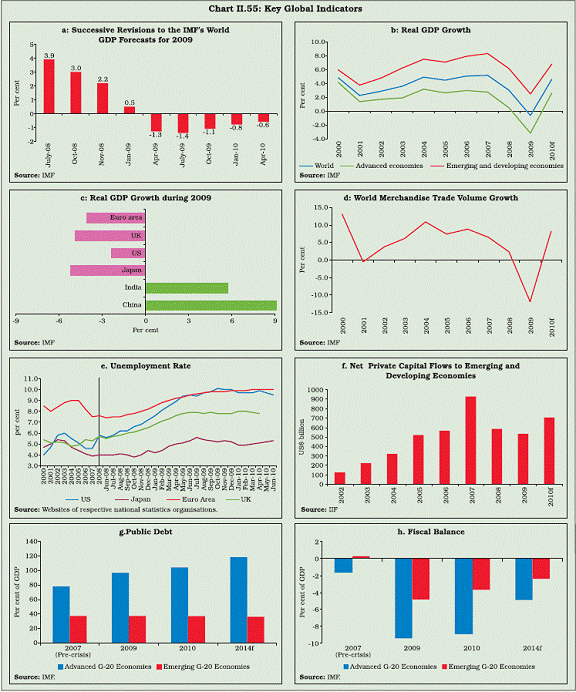 |
 |
Merchandise Trade
II.6.7 Contraction in global trade volume was
much sharper than the contraction in global GDP
in 2009, and the impact on India’s merchandise
exports was visible in terms of negative growth over
12 successive months during October 2008 to
September 2009. India’s merchandise exports
witnessed a turnaround in October 2009. A durable
recovery in world demand will be critical to sustain
the strong positive export growth experienced
during November 2009 to June 2010, when the
monthly average growth of exports was 32.9 per
cent. Merchandise imports also contracted over
eleven successive months; the recovery in domestic
economic activity and resurgence in oil prices led
to a rebound in India’s imports, since November
2009. As a result, imports witnessed a robust
growth at a monthly average of 47.9 per cent during December 2009 to June 2010 (Chart II.56a and b).
The impact of the global crisis on export
performance of various countries in 2009 was
divergent. Countries like Indonesia, India, China,
Switzerland, Korea and the US recorded a relatively
lower decline in exports than the world average
(Chart II.57).
II.6.8 Recognising the pressure on export
performance from adverse global developments, the
Government of India had announced a number of
incentive measures in the Union Budget 2009-10 and
Foreign Trade Policy (2009-14) to promote export
growth. The Union Budget for 2009-10 announced
measures such as extension of period of the “Adjustment Assistance Scheme” for badly hit export
sectors, extension of period for interest subvention
of 2 per cent on pre-shipment export credit, and
extension of the period for income tax benefits to
export sector, etc. In the Foreign Trade Policy (2009-
14), new products and new markets were added to
the Focus Market Scheme (FMS) and Focus Product
Scheme (FPS). Market Linked Focus Product Scheme (MLFPS) was expanded by inclusion of
various products. To facilitate technological
upgradation of the export sector and thereby
enhance competitiveness of exports, Export
Promotion Capital Goods (EPCG) scheme at zero
duty was introduced for various export sectors. India’s
comparative advantage in specific export items was
affected in the wake of the global crisis (Box II.12).
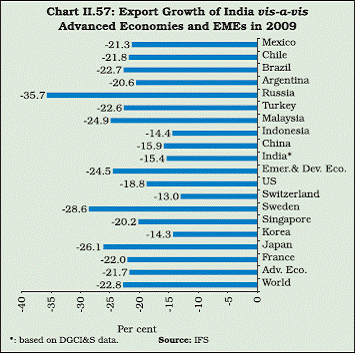 |
Box II.12
India’s Export Basket : An Assessment of Comparative Advantage
In India, sustained growth in merchandise exports
witnessed in the pre-global crisis was accompanied by
structural shifts in both commodity composition as well as
product and market diversification. The export growth
moderated from an average of about of 25 per cent during
the period 2002-03 to 2007-08 to (-)3.6 per cent in 2009-10.
In the phase of economic recovery in the midst of an
adverse external environment, for ensuring return to the
pre-global crisis performance in the export sector, it is
important to examine the comparative advantage of India
in different commodities across markets.
Available empirical evidence suggests that the level of
development of a country and the diversification in its
export basket could be correlated. Cadot et al. (2007) found
a hump shaped pattern of export diversification, i.e., low
and middle income countries diversify mostly along the
extensive margin (addition of new product lines) whereas
high income countries diversify along the intensive margin
(diversification of export values among active product lines)
and ultimately re-concentrate their exports towards fewer
products.
An analysis of India’s export basket in terms of revealed
comparative advantage (RCA) provides some insights in
to the competitiveness of India’s exports. The concept of
RCA (Balassa, 1965 and 1977) pertains to the relative
trade performance of individual countries in particular
commodities. An economy’s comparative advantage gets
influenced by various factors such as integration of the
economy with the world, liberalisation policies adopted by
the country for its external sector, rates of change in factor
accumulation, growth and development levels of the
economy and the productivity. Balassa measures the index
of RCA as follows :
 |
The analysis of commodity composition of India’s export
basket unveils that India has an RCA in chemicals agricultural products, fuels and mining products, iron and
steel, textiles and clothing (Chart A). India’s RCA in most
of its major exports is also borne out by the fact that
India’s average shares in world exports in most of these
product groups have witnessed a significant increase
during the 2000s. Furthermore, the terms-of-trade effect
emanating from relatively high export prices realised visà-
vis import prices also helped in achieving the high
export growth in recent years in value terms. Over the
years, India’s exports have witnessed geographical
diversification as well. There is a need to diversify India’s
trade basket in favor of higher value added products and
more of technology intensive products so that the
economy could maximise the gains from trade and sustain
the growth of exports driven by improved competitive
advantage.
References
1. Balassa, B. (1965), “Trade Liberalisation and
‘Revealed’ Comparative Advantage”, The Manchester
School, 33, pp. 99-123.
2. Balassa, B. (1977), “‘Revealed’ Comparative
Advantage Revisited”, The Manchester School, 45, pp.
327-44.
3. Cadot, O., Carrere, C. and Strauss-Kahn, V. (2007),
“Export Diversification: What’s Behind the Hump?”;
Centre for Economic Policy Research Discussion
Paper No. 6590.
II.6.9 Despite the demand induced moderation in
export growth resulting from the global recession,
India’s exports performed relatively better as its
rank among leading exporters improved from 27th
in 2008 to 22nd in 2009, with the share in world
exports at 1.2 per cent. India ranked 15th among
leading importers in 2009, with a share of 1.9 per
cent, which also represents an improvement over
16th position in 2008. Since India’s GDP growth
remained ahead of most countries, its import growth
accordingly would have been relatively higher,
leading to the higher rank among importers.
II.6.10 The disaggregated commodity and
direction of trade data reveal that India’s trade in
all major commodity groups and with major trading
partners registered a decline/deceleration during
2009-10 (Charts II.58 a to d). However, exports of
primary products and petroleum products
registered a positive growth in 2009-10. Also,
exports of gems and jewellery have turned around
since Q3 of 2009-10. Similarly, imports of crude oil
started rising with the increase in its price.
II.6.11 Overall, India’s exports and imports
contracted by 3.6 per cent and 5.6 per cent,
respectively, during 2009-10 as against a growth
of 13.7 per cent in exports and 20.8 per cent in
imports last year. As the decline in imports was
steeper than the decline in exports, the overall trade
deficit was lower during the year. On balance of
payments basis, the trade deficit as a percentage
of GDP reduced from 9.8 per cent in 2008-09 to
8.9 per cent in 2009-10.
Invisibles
II.6.12 Invisibles receipts and payments had
witnessed deceleration in growth in 2008-09 in
relation to the robust growth performance in the precrisis
period. During 2009-10, invisible receipts
declined further by 1.4 per cent mainly on account
of decline in business, financial and communication
services and investment income receipts. In
contrast, invisible payments increased significantly
by 11.8 per cent due to increase in payments under investment income, financial and business services.
As a result, invisibles surplus declined by 12.2 per
cent to US$ 78.9 billion during 2009-10 from
US$ 89.9 billion in the previous year (Chart II.59a).
 |
II.6.13 Net services exports of India declined by
31.1 per cent during 2009-10 as against an
increase of 27.7 per cent during last year, mainly
due to significant decline in services receipts
coupled with an increase in services payments.
Growth in services receipts turned negative for the
first time after 1992-93, reflecting subdued global
private demand and decline in merchandise trade.
The decline in net services was spread over
transportation and miscellaneous services such as
business, financial and communication services.
Software services exports, which had declined
during the first half recovered during the second
half, resulting in a growth of 7.4 per cent during
2009-10. Non-software miscellaneous services
receipts, mainly on account of significant decline
in communication, financial and business services,
declined sharply to US$ 19.0 billion in 2009-10
from US$ 31.4 billion in 2008-09. Investment
income receipts also declined to US$ 12.1 billion
in 2009-10 from US$ 13.5 billion in 2008-09 on
account of low interest rate environment in
international markets.
II.6.14 Private transfer receipts, an important and
resilient component of invisibles receipts,
increased by 14.9 per cent to US$ 53.9 billion
during 2009-10 from US$ 46.9 billion in the previous
year (Chart II.59b). A Survey conducted by the Reserve Bank in November 2009 suggested an
insignificant impact of the global crisis on
remittance inflows to India. The responses from
different cities though varied, ranging from
significant impact (such as Kochi) to no decline
(such as Ahmedabad).
Current Account Balance
II.6.15 On balance of payments basis, trade deficit
decreased marginally to US$ 117.3 billion (8.9 per
cent of GDP) during 2009-10 from US$ 118.7 billion
(9.8 per cent of GDP) in 2008-09 (Chart II.60).
Lower net invisibles during 2009-10 financed about
67.3 per cent of trade deficit as compared with 75.8 per cent in the previous year. Despite lower
trade deficit, the decline in invisibles surplus led
to a higher current account deficit of 2.9 per cent
of GDP during 2009-10 as compared with 2.4 per
cent of GDP a year ago.
Capital Account
II.6.16 Stronger recovery in India ahead of the
global recovery coupled with positive sentiments
of global investors about India’s growth prospects
induced the revival in capital inflows during
2009-10. The turnaround in the capital inflows was
mainly driven by large inflows under Foreign
Institutional Investors’ (FIIs) investments and shortterm
trade credits. Net FII inflows of US$ 29.0 billion
represented a major reversal from the outflow of
US$15.0 billion experienced during the previous
year. Net FDI inflows were higher at US$ 19.7 billion
during 2009-10 as compared to US$ 17.5 billion
during 2008-09, reflecting steady inflows coupled
with lower gross outflows (Chart II.61).
II.6.17 Country-wise, investments routed through
Mauritius remained the largest component of
gross FDI inflows to India during 2009-10,
followed by Singapore and the USA (Chart II.62).
During 2009-10, FDI was mainly channeled into the manufacturing sector (22.9 per cent), followed
by the construction sector (15.7 per cent), financial
services and real estate sector (9.8 per cent each)
(Chart II.63).
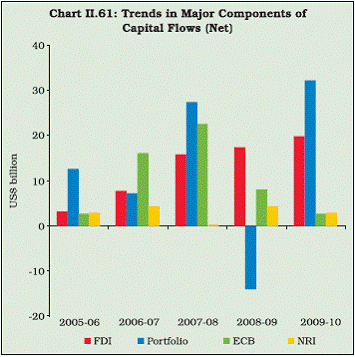 |
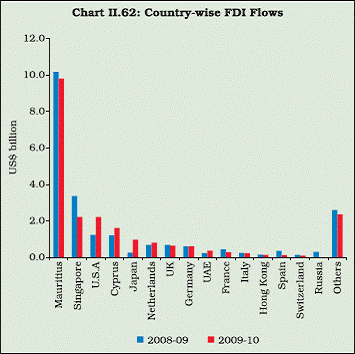 |
II.6.18 After recording net inflows under Nonresident
deposits during the first three quarters,
there were outflows during the last quarter of the
2009-10 reflecting the impact of decline in effective interest rate on such deposits as well as
appreciation of the rupee against the US dollar. Net
external assistance received by India during 2009-10
was lower at US$ 2.4 billion. Net external
commercial borrowings were significantly lower
during 2009-10 mainly due to lower disbursements,
especially in the first quarter, coupled with higher
repayments. Short term trade credit also exhibited
a turnaround since the second quarter of 2009-10
and recorded net inflows of US$ 7.7 billion during
the full year. Net capital inflows during 2009-10
stood significantly higher at US$ 53.6 billion as
compared with US$ 7.2 billion in 2008-09, mainly
driven by FDI, portfolio investment and short-term
trade credits.
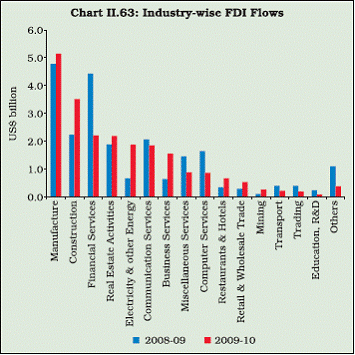 |
II.6.19 During 2010-11 so far, FDI inflows have
remained stable, while FII inflows have also
witnessed improvement. Similarly, ECB approvals
have been large during 2010 (April-July) reflecting
strong domestic investment demand.
II.6.20 India experienced high volatility in capital
flows in recent years. Capital flows have also been
the dominant factor in inducing volatility in the
exchange rate of the rupee against the US dollar.
The exchange rate appreciated when there were
large capital inflows and depreciated when the
capital inflows ebbed or turned into outflows. Given
the stated policy of the Reserve Bank to contain
volatility in the exchange rate, without reference
to any specific target or band, its net intervention
operations have helped in absorbing significantly
the pressure of capital flows on exchange rate volatility. In recent years, however, the exchange
rate has become relatively more flexible,
particularly in relation to the size of net intervention
operations of the Reserve Bank. In 2009-10, for
example, net interventions were negligible,
whereas the exchange rate appreciated by 12.9
per cent (Chart II.64). Even though it partly
reflected correction for the significant depreciation
witnessed in 2008-09 in the wake of the global
crisis, the nominal appreciation entailed dual
effects on the economy (Box II.13). During 2010-
11 so far (up to August 16, 2010), the Indian rupee
has generally depreciated against the US dollar
by 3.5 per cent while it has appreciated against
the euro.
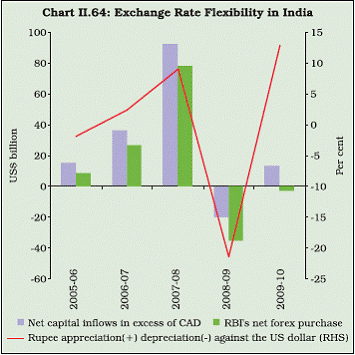 |
Box II.13
Impact of Exchange Rate Movement on the Economy
In a flexible exchange rate regime, movements in exchange
rate could have dual effect on the overall macroeconomic
conditions. While an exchange rate appreciation could help
in moderating domestic inflation through lower cost of imports
expressed in domestic currency, it could also weaken the
competitive advantage of exports and thereby adversely
affect growth. If a nominal appreciation coincides with higher
inflation differentials, then the resultant appreciation of the
Real Effective Exchange Rate (REER) could further magnify
the pressure on competitiveness. In 2009-10, the 6-curency trade based REER of the Indian rupee appreciated by 20.0
per cent (Chart A).
Available empirical findings for India on the pass-through
of exchange rate changes to domestic prices provide a
range of results. RBI (2004) estimated that a 10 per cent
depreciation of exchange rate increased wholesale prices
by 0.4 per cent during the period 1970 to 2004. About 60
per cent of pass-through was estimated to take place within
one year. A study by Khundrakpam (2007) for the post- reform period (August 1991 to March 2005) estimated the
pass-through coefficients and found that a 10 per cent
change in exchange rate leads to change in final prices by
about 0.6 per cent in the short-run and 0.9 per cent in the
long-run. The same study suggested no decline in the degree
of pass-through over time, unlike what has been found in
other countries. These estimates in the range of 0.4 per cent
to 0.9 per cent suggest that 12.9 per cent appreciation
experienced in 2009-10, would have helped in moderating
the inflation by 0.5 per cent to 1.2 per cent. This impact,
though, would be over a period of time, and not entirely
during the year itself.
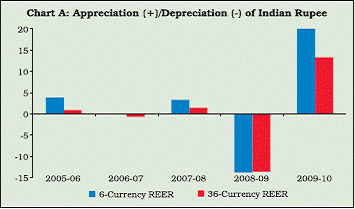 |
The impact of exchange rate appreciation on trade balance
could depend on the degree of pass-through of exchange
rate changes to export and import prices, as well as importintensity
of exports. At times, the impact of other determinants
of exports and imports, such as productivity driven
comparative advantages as well as demand-supply conditions
could dominate the exchange rate impact. Empirical evidence
generally corroborates the perception that both exports and
imports remain sensitive to exchange rates even when other
determinants of trade flows change significantly (Smith, 2004;
Sharma, 2000; Kandil, et al. 2007).
For India, the estimated impact of currency movements on
trade balance for the period 1996Q2 to 2009Q4 appears to
be statistically significant. A simple regression of trade balance
(used in terms of the ratio of exports to imports, i.e. LXM) on
exchange rate (6-currency trade weighted real effective
exchange rate, i.e. LREER), seasonally adjusted domestic
real GDP (LINGDP) and World GDP (proxied by the
seasonally adjusted OECD GDP, i.e. LOECDGDP) show that
growth in domestic GDP worsens trade balance (possibly
through boosting import demand relative to exports from the
supply side), while growth in world GDP improves India’s trade
balance (through the impact on exports on the demand side).
The currency appreciation worsens the trade balance
significantly; the estimated coefficient shows that a one per
cent real appreciation would invoke almost 0.7 per cent
deterioration in trade balance.
 |
Based on the favourable impact of exchange rate appreciation
on inflation, it was viewed in some quarters during 2009-10
that the exchange rate channel of monetary policy was
effective in containing inflation. In India, however, other than
containing excessive volatility, the Reserve Bank does not
condition the path of the exchange rate. Since the Reserve
Bank had to balance the dual objectives of stronger recovery
and lower inflation during 2009-10, even in the use of
monetary policy measures, the actions had to be calibrated
carefully. In a phase of managing the recovery, particularly
given the adverse external demand conditions and
protectionism concerns, any exchange rate appreciation could
have been expected to undermine the growth objective more
than during normal times. Besides dampening export growth,
even cheaper imports that compete with domestic import
substitutes could substantially thwart a faster recovery. Unlike
managing the inflation-growth objectives through monetary
policy measures, attempting the same through exchange rate
could expose the economy to external sector risks that could
be difficult to manage. There have been country experiences
of devaluation – hyper inflation’s vicious path on the one hand,
as well as dutch disease effects associated with sustained
large appreciation on the other. The Reserve Bank recognises
the risks of using exchange rate as an instrument for managing
internal balance versus external balance objectives, and that
is why it operates with a market determined exchange rate
regime, where the rate itself is determined by several
determinants, including inflation, trade and capital flows, and
economic growth.
References
1. Khundrakpam, J.K. (2007), “Economic Reforms and
Exchange Rate Pass-through to Domestic Prices in
India”, BIS Working Paper No. 225.
2. Reserve Bank of India (2004), Report on Currency and
Finance 2003-04.
3. Kandil, M., Berument, H. and Dincer, N. N. (2007), “The
Effects of Exchange Rate Fluctuations on Economic
Activity in Turkey,” Journal of Asian Economics, 18, 466–
89.
4. Smith, M. (2004), “Impact of the Exchange Rate on
Export Volumes,” Reserve Bank of New Zealand
Bulletin, 67(1), 1-13.
5. Sharma, K. (2000), “Export Growth in India: Has FDI
Played a Role?,” Center Discussion Paper No. 816, Yale
University, July.
Foreign Exchange Reserves
II.6.21 During 2009-10, net capital account
surplus, after financing a larger current account
deficit, resulted in a net accretion to foreign
exchange reserves of US$ 13.4 billion (excluding
valuation effect). Including the valuation gains
resulting from depreciation of the US dollar vis-àvis
other non-US dollar currencies in which part of
the reserves are maintained and increase in price
of gold, the foreign exchange reserves increased
by US$ 27.1 billion during the year. There were
two transactions relating to purchase of gold from
the IMF and allocation of SDRs by the IMF, which
affected the level as well as composition of the
reserves. The IMF made additional allocations of
SDRs to India in two tranches, viz., general
allocation of SDR 3,082 million (equivalent to US$
4.82 billion) on August 28, 2009 and a special
allocation of SDR 214.6 million (equivalent to US$
0.34 billion) on September 9, 2009. As a result,
while the external liabilities of the Government increased in the capital account of the balance of
payments, equivalent increase in the foreign
exchange reserves was recorded in the form of
SDR holdings. Unlike the SDR allocation, the
purchase of 200 metric tonnes of gold from the IMF
involved only a shift in the composition of reserves,
as the increase in reserves in the form of gold was
offset by corresponding fall in foreign assets. Of
the US$ 27.1 billion increase in reserves (including
valuation), the component-wise increases were
US$ 13.3 billion in foreign currency assets, US$
8.4 billion in gold, US$ 5.0 billion in SDRs and US$
0.4 billion in RTP. Despite larger capital inflows than
the previous year, foreign exchange reserves
increased moderately during 2009-10, reflecting
increased absorption through higher current
account deficit. India’s foreign exchange reserves
stood at US$ 287.4 billion as on August 6, 2010.
During 2009-10, several initiatives at the global level
were taken to supplement national safety nets for
dealing with adverse global shocks in future
(Box II.14)
Box II.14
Global Initiatives to Supplement National Policies in Dealing with External Shocks
The experience of the recent financial crisis has amply
demonstrated that in a globalised world, despite having a
sound domestic macro-financial policy environment, a
country could still face a crisis because of external shocks.
Many EMEs like India that did not contribute directly to
the global crisis nor did they have any direct exposure to
the troubled assets and financial instruments in the
advanced economies, were still affected by the crisis.
Hence, credible and effective global systems must be put
in place to supplement national policies for dealing with
external shocks which could potentially spread fast with
devastating consequences for economies.
Keeping in view the global dimension of the recent
financial crisis, it was felt at the outset itself that the efforts
towards restoring balance needed to be exceptional
transcending national boundaries. This was reflected in
the provision of cross-border liquidity through swap
arrangements by major central banks as well as several
rounds of policy rate cuts. International institutions for
policy coordination like the G-20, global financial
institutions like the IMF and the World Bank as well as
many regulatory institutions became active as also new
institutions like Financial Stability Board (FSB) have been
instituted. In the midst of the crisis, the G-20 exhibited exceptional coordination in responding to the contagion
of the crisis with swift national policy measures. With
regard to regulatory reforms, the G-20 is closely
coordinating the efforts of international institutions like
Basel Committee on Banking Supervision (BCBS),
International Organisation of Securities Commissions
(IOSCO) and International Association of Insurance
Supervisors (IAIS) regarding international rules on
capital, leverage and liquidity, compensation reforms,
OTC derivatives, prudential regulation of Systematically
Important Financial Institutions (SIFIs), accounting
standards and credit rating agencies.
Besides national monetary and financial stimulus
measures, there was reliance on expanded financial safety
nets, ranging from swap facilities from the Fed to national
central banks to augmenting the financial resources of the
IMF. At its London Summit in April 2009, the G-20 members
expressed their joint commitment to treble the resource
base of the IMF to US$ 750 billion, apart from support for
trade finance, additional lending by multilateral
development banks (MDBs) and concessional finance to
poorest countries from proceeds of IMF gold sales.
Subsequently, the IMF has made efforts to improve the
financial safety nets of member countries through SDR
allocations. The IMF has also revamped its extant lending
instruments and devised new instruments to deliver timely
resources to the economies facing financial stress. In
addition to the traditional credit lines, it has instituted a
Flexible Credit Line (FCL) for countries with strong macro
fundamentals and the High Access Precautionary
Arrangements (HAPAs) for countries that may not qualify
for FCL. Reflecting the change of approach at the global
level, in response to the sovereign debt crisis in Greece,
the IMF in coordination with the European Commission,
pledged to provide a three year US$ 40 billion Stand-by
Arrangement to Greece, amounting to 32 times of its
Quota in the IMF.
India’s Role in the Emerging Global Initiatives
As an active member of the G-20, India stands committed
to emerging global initiatives, recognising fully that global
problems need global solutions. The G-20 Working Group
on ‘Enhancing Sound Regulation and Strengthening
Transparency’ was Co-chaired by India. The Government
of India had constituted a High Level Committee (HLC)
to follow-up on the G-20 Washington Summit Declaration
and constituted four Indian/Internal Working Groups,
which mirrored the G-20 Working Groups. Separately, the
RBI had set up two cells on the G-20 Working Groups
viz., “Strengthening Transparency and Enhancing Sound Regulation” and “International Co-operation and Market
Integrity”, respectively.
In order to strengthen the IMF’s lendable resources, the
RBI has entered into a Note Purchase Agreement (NPA)
with the IMF under which the RBI shall purchase from
the IMF notes for an amount up to the equivalent of US$
10 billion. India has bought the IMF gold. The sale
proceeds of gold are expected to boost IMF’s capacity to
provide concessional loans to low income countries.
With respect to prudential regulations, ten large Indian
banks are participating in the current round of quantitative
impact assessment (QIS) being conducted by the BCBS.
The Reserve Bank is working on the FSB principles for
sound compensation and accordingly, comprehensive
guidelines based on FSB principles on sound
compensation practices was issued on July 1, 2010. Also,
setting up a Working Group to work out the modalities for
an efficient, single point reporting mechanism for all OTC
interest rate and forex derivative transactions was
proposed.
While the emerging regulatory responses of countries and
the development of new international standards would need
to be examined in the context of India specific needs and
relevance before application, many of the new international
initiatives may not require a revision of the country’s current
policies on capital flows, exchange rate and foreign
exchange reserves, which have helped effectively in limiting
the country’s vulnerability to external shocks.
Management of Foreign Exchange Reserves
II.6.22 The guiding objectives of foreign exchange
reserves management in India are safety, liquidity
and returns in line with the general international
practices in this regard. The variations in India’s
foreign exchange reserves are an offshoot of its
exchange rate policy, which is to intervene in the
market only to smooth exchange rate volatility and
prevent disruptions in macroeconomic stability.
Since no deliberate strategy of reserve
accumulation is pursued through a policy of
sustained current account surplus, India does not
contribute to global imbalances. Moreover, the
reserves are built up against borrowed resources,
and hence they are used during periods of sudden
stops and reversal in capital flows. Variation in
reserves, thus, besides the valuation effects arising
from changes in international currencies in which the reserves are held, largely reflect the result of
trends in capital flows.
II.6.23 The Reserve Bank purchased 200 metric
tonnes of gold from the IMF during October 19-30,
2009 under the IMF’s limited gold sales programme.
This was done as part of the Reserve Bank’s
foreign exchange reserve management operations.
The foreign exchange reserves, however, remained
unaffected by this transaction as it merely reflected
substitution of foreign currency assets by gold. As
a result, the share of gold in total reserves went
up to 6.3 per cent at end-November 2009 from
3.8 per cent at end-October 2009 prior to the gold
purchase.
External Debt
II.6.24 India’s external debt stock increased by
16.5 per cent to US$ 261.5 billion at the end of March 2010 on account of significant increase in
SDR related liabilities, commercial borrowings,
trade credits and NRI deposits. While long term
debt increased by US$ 27.8 billion to US$ 209.0
billion, short-term debt increased by US$ 9.1 billion
to US$ 52.5 billion on the basis of original maturity.
Based on residual maturity, short-term debt stock
stood at US$ 107.6 billion accounting for 41.2 per
cent of the total external debt at end-March 2010.
In terms of currency composition, the US dollar
denominated debt accounted for the major portion
of total external debt at end-March 2010. Various
debt sustainability indicators remained at
comfortable level (Chart II.65).
II.6.25 The international assets increased from
US$ 346.2 billion at end-March 2009 to US$ 378.8
billion at end-March 2010, mainly on account of
increase in direct investment abroad and reserve
assets. The increase in international liabilities from
US$ 409.0 billion as at end-March 2009 to US$
536.5 billion as at end-March 2010 was mainly on
account of an increase in inward direct and portfolio
investments and other investments. Net claim of
non-residents on India reflecting the net
International Investment Position (International
Assets minus International Liabilities) increased from
the level of US$ 62.8 billion as at end-March 2009 to US$157.6 billion as at end-March 2010. The
build-up of foreign exchange reserves in recent
years also helped in containing increase in net
international liabilities. While net liabilities increased
by US$ 94.8 billion, net capital inflows were at US$
53.6 billion; the difference between the two largely
reflects valuation effects.
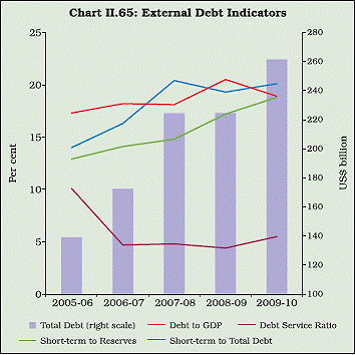 |
II.6.26 The external sector outlook for 2010-11
suggests the persistence of large current account
deficit albeit with some moderation. Since India’s
growth is expected to be stronger, resultant import
growth could widen the trade deficit. Uncertainties
in international oil prices could exert additional
pressure. Despite diversification of the export
basket and pick up in export growth in recent
months, sustaining a robust export growth would
be a challenge. The developments observed
during 2009-10 for services exports may continue
during 2010-11 if the global recovery weakens due
to sovereign debt concern in the Euro zone. As
projected by NASSCOM, however, software
exports could recover in 2010-11 to grow by
13-15 per cent as against 5.5 per cent in 2009-
10. If the crisis in the Euro zone deepens, that
would impact both exports and private transfer
receipts. The share of India’s exports to Europe
has been about 20 per cent in recent period;
Europe is also one of the major regions
contributing to India’s private transfers.
II.6.27 The expected surge in capital flows, and
the associated pressure on exchange rate and
asset prices will have to be managed. A higher
current account deficit, however, could absorb
higher capital flows more productively. The
financing needs of infrastructure as well as
expected higher current account deficit suggest the
importance of foreign capital for economic growth.
Capital flows in the initial months of 2010-11 have
moderated somewhat, reflecting the drop in risk
appetite of global investors in response to the
sovereign risk concerns in the Euro zone. Due to
favourable market sentiments, however, capital
flows to India have picked up since June 2010 as
reflected in higher portfolio inflows coupled with large ECB approvals. Given the stronger growth
outlook of India and the probability of monetary exit
being delayed by the advanced economies, capital
inflows could be expected to accelerate, which will
have to be managed, as in the past. The balance
of payments outlook for 2010-11, thus, suggests
that notwithstanding a higher current account
deficit, higher capital flows, comfortable reserves
and a flexible exchange rate will help in managing
the external sector challenges.
VII. OVERALL ASSESSMENT
II.7.1 Overall, the macro-financial developments
during 2009-10 indicated the resilience of the
economy to shocks, both external and internal, as
well as the capacity to recover fast from an
economic slowdown. Domestic policy stimulus, both
monetary and fiscal, contributed to spur the
recovery impulses. However, timely exit from the
stimulus had to be initiated in the second half of
the year, recognising its importance for containing
inflation in the near-term as well as supporting high
sustainable growth in the medium-term. The
assessment based on inter-sectoral linkages
suggests that the impact of any weakness in
agricultural production resulting from deficient
rainfall on the growth prospects of industry and
services has moderated over time. Agricultural
growth, however, continues to be critical from the
standpoint of its impact on inflation and rural
demand conditions.
II.7.2 In managing the recovery, monetary policy
measures encountered the usual transmission
weaknesses, even though ample liquidity conditions
created by the Reserve Bank helped in allaying any
liquidity concerns in the financial system. Adequate
availability of resources from both banks and nonbanking
sources also ensured financing of real
activities during the recovery. With the usual lags
in monetary policy transmission, lending rates
started to moderate gradually and the demand for
credit from the private sector also recovered in the
second half of the year.
II.7.3 Continuation of the expansionary fiscal
stance adopted in response to the contagion from
the global crisis helped in partly offsetting the
dampening impact of decelerating private
consumption demand on the recovery. Fiscal
imbalances, however, when persist, could pose
risks to the inflation situation, the potential output
path and the external balance conditions. In the
Union Budget for 2010-11, the beginning of fiscal
exit was announced along with a medium-term
fiscal consolidation plan. 3G/BWA spectrum
auction proceeds, which turned out to be almost
three times the amount that was expected, is
unlikely to contribute to a faster fiscal correction
because of the additional expenditures as
reflected in the first batch of Supplementary
Demands for Grants for 2010-11. The deregulation
of petrol prices and upward revisions to prices of
other petroleum products effected in June 2010
would, however, ease the stress on the fiscal
situation going forward, notwithstanding the nearterm
pressures on headline inflation.
II.7.4 The key macroeconomic concern in the
second half of the year was the rising generalised
inflation, which warranted rebalancing the weights
of different objectives pursued through monetary
policy, with increasing accent placed on
containment of inflation. Decline in relative price
variability as well as evidence of inflation
persistence implied the need for use of monetary
policy actions, even though the initial source of
pressure on inflation started from an adverse
supply shock in response to the deficient
monsoon. Structural supply side constraints that
impart sustained or frequent pressure on the
inflation path need to be addressed so as to
enhance the capacity to ensure a low inflation
regime.
II.7.5 The financial markets, despite exhibiting
intermittent volatility reflecting sporadic uncertain
global developments, functioned normally with
rising activities, which was necessary for ensuring
faster recovery. Strengthening the financial
stability architecture further and promoting
development of deeper financial markets, however, would have to receive sustained policy focus,
going forward. The external balance situation,
which had come under pressure from decline in
exports and net capital outflows in the wake of
the global crisis, improved during the year with
the return of positive growth in exports and revival
in capital flows. Higher current account deficit also
contributed to the recovery through better
absorption of foreign capital. Management of
capital flows would continue to be a major
challenge, given their dual ramifications in terms
of a potential source of instability as well as a
means to higher growth and productivity.
II.7.6 Thus, while at the beginning of the year the
overriding macroeconomic concern was faster and
stronger recovery, by the end of the year that concern
had subsided significantly, but an equally
discomforting concern had surfaced in the form of high
and generalised inflation. In dealing with the challenge
of inflation through monetary tightening, the
associated consequences in terms of attracting
excessive interest rate sensitive capital inflows and
also harming the recovery by raising the cost of capital
had to be recognised, which was reflected in the
Reserve Bank’s calibrated approach to unwinding of
its monetary policy stimulus to the recovery.
1 Increase in repo/OMO purchases and decline in reverse repo/MSS balances/government’s surplus balances with Reserve Bank lead to increase in net Reserve Bank credit to the Centre, and vice versa.
2 Report of the Committee on Financial Sector Assessment (CFSA) 2009, Volume 2, Page 282. |